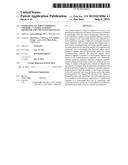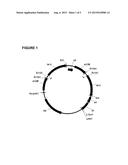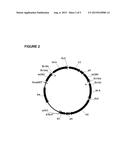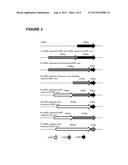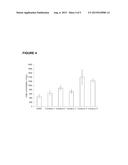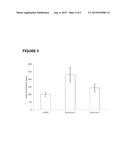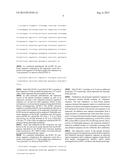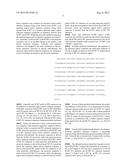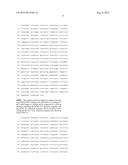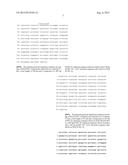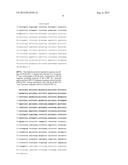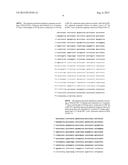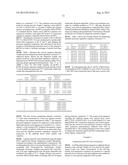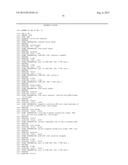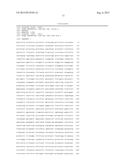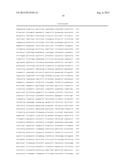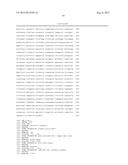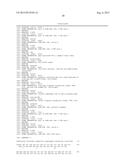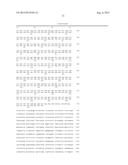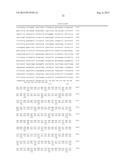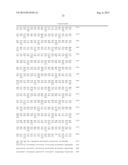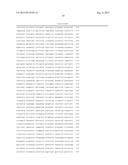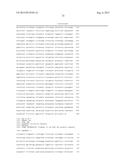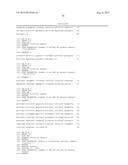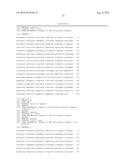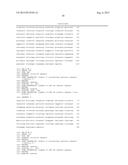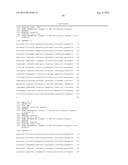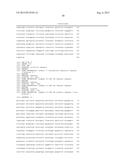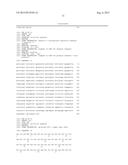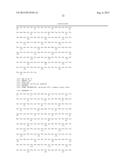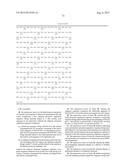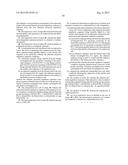Patent application title: EXPRESSION VECTORS COMPRISING CHIMERIC CYTOMEGALOVIRUS PROMOTER AND ENHANCER SEQUENCES
Inventors:
Tom Payne (Cambridge, GB)
Robert Young (London, GB)
Marc Feary (Suffolk, GB)
IPC8 Class: AC12N1585FI
USPC Class:
Class name:
Publication date: 2015-08-06
Patent application number: 20150218584
Abstract:
The present invention relates to expression vectors for the heterologous
expression of a nucleic acid sequence of interest in mammalian cells, the
vectors comprising a chimeric promoter regulatory sequence being operably
linked to a nucleic acid sequence to be expressed, wherein the chimeric
promoter regulatory sequence comprises a cytomegalovirus promoter
sequence derived from murine cytomegalovirus or from human
cytomegalovirus and being operably linked to the transcriptional start
site of the nucleic acid sequence to be expressed; and a cytomegalovirus
upstream region and/or enhancer sequence derived from human and/or the
simian cytomegalovirus, wherein the upstream region and/or enhancer
sequence is located 5' of and operably linked to the murine or the human
promoter sequence, and wherein the chimeric promoter regulatory sequence
comprises sequence elements being derived from at least two of the group
consisting of murine cytomegalovirus, human cytomegalovirus and simian
cytomegalovirus. In particular embodiments, the chimeric promoter
regulatory sequence comprises sequence elements derived from the murine
or the human cytomegalovirus IE1 promoter and from the human and/or the
simian cytomegalovirus IE1 region. The invention also relates to
mammalian host cells transfected with such expression vectors, a method
for heterologous expression of a nucleic acid sequence in a mammalian
host cell by employing such expression vectors, and the use of such
expression vectors for the heterologous expression of a nucleic acid
sequence.Claims:
1-17. (canceled)
18. An expression vector for the heterologous expression of a nucleic acid sequence of interest in mammalian cells, the vector comprising a first chimeric promoter regulatory sequence being operably linked to a first nucleic acid sequence to be expressed, wherein the chimeric promoter regulatory sequence comprises: (i) a promoter sequence being selected from the murine cytomegalovirus IE1 promoter consisting of the nucleotide sequence of SEQ ID NO: 4 or the human cytomegalovirus IE1 promoter consisting of SEQ ID NO: 5 and being operably linked to the transcriptional start site of the nucleic acid sequence to be expressed; and (ii) an enhancer sequence from the human and/or the simian cytomegalovirus IE1 region, the enhancer sequence being located 5' of and operably linked to the murine or the human promoter sequence, and wherein the chimeric promoter regulatory sequence comprises sequence elements from at least two of the group consisting of murine cytomegalovirus, human cytomegalovirus and simian cytomegalovirus.
19. The expression vector of claim 18, wherein the enhancer sequence comprises the nucleotide sequence of SEQ ID NO: 6 from the simian cytomegalovirus IE1 region.
20. The expression vector of claim 18, wherein the chimeric promoter regulatory sequence comprises a nucleotide sequence being selected from the group consisting of SEQ ID NO: 7, SEQ ID NO: 8, SEQ ID NO: 9, SEQ ID NO: 10, SEQ ID NO: 11, SEQ ID NO: 12, and SEQ ID NO: 13.
21. The expression vector of claim 18, further comprising a second chimeric promoter regulatory sequence being operably linked to a second nucleic acid sequence to be expressed, wherein the second chimeric promoter regulatory sequence is identical to the first chimeric promoter regulatory sequence.
22. The expression vector of claim 21, wherein the first and second nucleic acid sequences to be expressed encode different polypeptides.
23. The expression vector of claim 22, wherein the different polypeptides represent subunits of a dimeric or multimeric protein.
24. The expression vector of claim 23, wherein dimeric or multimeric protein is an antibody molecule.
25. The expression vector of claim 18, further comprising a second chimeric promoter regulatory sequence being operably linked to a second nucleic acid sequence to be expressed, wherein the second chimeric promoter regulatory sequence is different from the first chimeric promoter regulatory sequence.
26. The expression vector of claim 25, wherein the first and second nucleic acid sequences to be expressed encode different polypeptides.
27. The expression vector of claim 26, wherein the different polypeptides represent subunits of a dimeric or multimeric protein.
28. The expression vector of claim 27, wherein dimeric or multimeric protein is an antibody molecule.
29. A mammalian host cell transfected with an expression vector, the vector comprising a first chimeric promoter regulatory sequence being operably linked to a first nucleic acid sequence to be expressed, wherein the chimeric promoter regulatory sequence comprises: (i) a promoter sequence being selected from the murine cytomegalovirus IE1 promoter consisting of the nucleotide sequence of SEQ ID NO: 4 or the human cytomegalovirus IE1 promoter consisting of SEQ ID NO: 5 and being operably linked to the transcriptional start site of the nucleic acid sequence to be expressed; and (ii) an enhancer sequence from the human and/or the simian cytomegalovirus IE1 region, the enhancer sequence being located 5' of and operably linked to the murine or the human promoter sequence, and wherein the chimeric promoter regulatory sequence comprises sequence elements from at least two of the group consisting of murine cytomegalovirus, human cytomegalovirus and simian cytomegalovirus.
30. The mammalian host cell of claim 29, wherein the chimeric promoter regulatory sequence of the expression vector comprises a nucleotide sequence being selected from the group consisting of SEQ ID NO: 7, SEQ ID NO: 8, SEQ ID NO: 9, SEQ ID NO: 10, SEQ ID NO: 11, SEQ ID NO: 12, and SEQ ID NO: 13.
31. The mammalian host cell of claim 12, wherein the host cell is a CHO cell.
32. A method for heterologous expression of a nucleic acid sequence of interest in a mammalian host cell, comprising: (i) transfecting the mammalian host cell with an expression vector, the vector comprising a first chimeric promoter regulatory sequence being operably linked to a first nucleic acid sequence to be expressed, wherein the chimeric promoter regulatory sequence comprises: (xi) a promoter sequence being selected from the murine cytomegalovirus IE1 promoter consisting of the nucleotide sequence of SEQ ID NO: 4 or the human cytomegalovirus IE1 promoter consisting of SEQ ID NO: 5 and being operably linked to the transcriptional start site of the nucleic acid sequence to be expressed; and (xii) an enhancer sequence from the human and/or the simian cytomegalovirus IE1 region, the enhancer sequence being located 5' of and operably linked to the murine or the human promoter sequence, and wherein the chimeric promoter regulatory sequence comprises sequence elements from at least two of the group consisting of murine cytomegalovirus, human cytomegalovirus and simian cytomegalovirus; and (ii) culturing the transfected mammalian host cell under conditions allowing the expression of the nucleic acid sequence of interest.
33. The method of claim 32, wherein the chimeric promoter regulatory sequence of the expression vector comprises a nucleotide sequence being selected from the group consisting of SEQ ID NO: 7, SEQ ID NO: 8, SEQ ID NO: 9, SEQ ID NO: 10, SEQ ID NO: 11, SEQ ID NO: 12, and SEQ ID NO: 13.
34. The method of claim 32, wherein the transfection is stable transfection.
35. Use of an expression vector as defined in any one of claims 18 to 25 for the heterologous expression of a nucleic acid sequence of interest in a mammalian host cell.
Description:
FIELD OF THE INVENTION
[0001] The present invention relates to mammalian expression systems, and in particular to expression constructs comprising chimeric promoter regulatory sequences for the heterologous expression of a nucleic acid sequence of interest in mammalian cells. The chimeric promoter regulatory sequences are composed of a promoter sequence derived from murine or from human cytomegalovirus and an upstream region and/or enhancer sequence derived from human and/or simian cytomegalovirus provided that the sequence elements are derived from at least two different cytomegalovirus species.
BACKGROUND
[0002] Recombinant (poly)peptides and proteins for applications in basic research, diagnostics, and therapy, such as antibody molecules, vaccines, hormones, and growth factors, are produced using a wide variety of genetically engineered organisms that include both prokaryotic and eukaryotic cells. However, the vast majority of recombinant peptides or proteins include post-translational modifications that cannot be mimicked or re-produced when using prokaryotic host cells. For this reason, mammalian gene expression systems have turned out to represent a preferred choice.
[0003] Mammalian expression systems based on Chinese Hamster ovary (CHO) cells are widely used in production of recombinant protein. Apart from lymphoid cell lines, CHO cells represent one of the few cell types allowing for simple and efficient high-density suspension batch culture of animal cells. Furthermore, the use of CHO cells results in high product yields, while lymphoid cells are more difficult to culture at an industrial scale. In view of considerable costs for recombinant production of polypeptides and proteins, it is also of utmost importance to maximize the yield of recombinant protein per bioreactor run. Process parameters that have considerable impact on product yield include inter alia the cell culture conditions, the copy number of the nucleic acids (genes) to be expressed, the efficiency with which these genes are transcribed and the corresponding mRNAs are translated, the stability of the mRNA, and the like.
[0004] Accordingly, improvements of the strength or transcriptional activity of the regulatory genetic elements controlling gene expression constitute a particularly critical factor in order to augment the yield of recombinant protein produced. Even small incremental increases in transcriptional activity at the single cell level will finally translate into considerable improvements in product yield in high-density industry-scale batch cultures.
[0005] The vast majority of mammalian gene expression systems employ expression vectors encoding the heterologous nucleic acid sequences to be expressed under the control of promoter regulatory sequences derived from viruses. Two of the most frequently used viral regulatory elements in these expression cassettes are those of the human cytomegalovirus (hCMV) immediate early genes 1 and 2 (IE1 and IE2). However, a disadvantage associated with the use of hCMV IE1 and IE2 regulatory elements is their pronounced species specificity.
[0006] U.S. Pat. No. 5,866,359 discloses that gene expression from such hCMV promoter can be improved by co-expressing adenoviral EIA protein under the control of a weak promoter. EIA is a multifunctional transcription factor which may act on cell cycle regulation and has both independent transcriptional activating and repressing functional domains. Fine tuning of EIA expression is crucial to achieve the ideal balance between gene transactivation and any negative impact on cell cycle progression. However, overexpression of EIA expression could reduce the capacity of the cell to synthesize the recombinant protein of interest.
[0007] U.S. Pat. No. 5,591,639 describes vectors comprising, upstream (5') of a heterologous nucleic acid sequence to be expressed, the enhancer, promoter, and complete 5'-untranslated region of the major immediate early gene of the human cytomegalovirus (hCMV-MIE) including intron A (i.e. the first natural intron). However, if the first 400 bp (5'-end) of this sequence (total length of about 2100 bp) were present, poor gene expression rates were observed in both COS7 and CHO cells (Chapman, B. S. et al. (1991) Nucl. Acids Res. 19, 3979-3986).
[0008] The transcriptional activity of the regulatory elements of the immediate early genes of the murine cytomegalovirus (mCMV) is higher than that of the hCMV counterparts without exhibiting the pronounced species preference observed for the human sequences (Addison, C. L. et al. (1987) J. Gen. Virol. 78, 1653-1661).
[0009] However, attempts to enhance the activity of the mCMV IE promoter regulatory elements, analogously to the hCMV counterparts, by insertion of the natural first intron of the murine major immediate early gene downstream (3') of the mCMV IE promoter failed (cf. inter alia EP patent 1 525 320 B1). However, the generation of expression vectors comprising a chimeric cassette composed of the regulatory elements of mCMV IE1 and the natural first intron of the human major immediate early gene resulted in product yields comparable to the use of the fully human sequences (cf., e.g., WO 2006/111387 A2). Similar gene expression rates were also obtained for expression vectors comprising the mCMV IE2 regulatory sequences (cf. inter alia EP patent 1 601 776 B1).
[0010] Thus, there still remains a need for improved mammalian gene expression systems resulting in high yields of the recombinant polypeptides or proteins produced. In particular, there is a need for mammalian gene expression systems that overcome the above-mentioned limitations, that is, expression systems based on the mCMV or the hCMV promoter sequences but achieving higher expression rates (and thus, product yields) than with the available system
[0011] Accordingly, it is an object of the present invention to provide such gene expression systems, primarily suitable expression constructs and corresponding mammalian host cells.
SUMMARY OF THE INVENTION
[0012] In one aspect, the present invention relates to an expression vector for the heterologous expression of a nucleic acid sequence of interest in mammalian cells, the vector comprising a first chimeric promoter regulatory sequence being operably linked to a first nucleic acid sequence to be expressed, wherein the chimeric promoter regulatory sequence comprises:
[0013] (i) a promoter sequence being derived from murine cytomegalovirus or from human cytomegalovirus and being operably linked to the transcriptional start site of the nucleic acid sequence to be expressed; and
[0014] (ii) an upstream region and/or enhancer sequence being derived from human and/or simian cytomegalovirus, wherein the upstream region and/or enhancer sequence is located 5' of and operably linked to the murine or the human promoter sequence; and wherein the chimeric promoter regulatory sequence comprises sequence elements being derived from at least two of the group consisting of murine cytomegalovirus, human cytomegalovirus and simian cytomegalovirus.
[0015] In particular embodiments, the promoter sequence is derived from the murine cytomegalovirus IE1 promoter; and/or the upstream region and/or enhancer sequence is derived from the human and/or simian cytomegalovirus IE1 enhancer.
[0016] In preferred embodiments, the murine cytomegalovirus IE1 promoter sequence has the nucleotide sequence of SEQ ID NO: 4.
[0017] In other particular embodiments, the promoter sequence is derived from the human cytomegalovirus IE1 promoter; and/or the upstream region and/or enhancer sequence is derived from the human and/or simian cytomegalovirus IE1 enhancer.
[0018] In preferred embodiments, the human cytomegalovirus IE1 promoter sequence has the nucleotide sequence of SEQ ID NO: 5.
[0019] In other preferred embodiments, the upstream region and/or enhancer sequence comprises the nucleotide sequence of SEQ ID NO: 6 being derived from the simian cytomegalovirus IE1 region.
[0020] In particularly preferred embodiments, the chimeric promoter regulatory sequence comprises a nucleotide sequence being selected from the group consisting of SEQ ID NO: 7, SEQ ID NO: 8, SEQ ID NO: 9, SEQ ID NO: 10, SEQ ID NO: 11, SEQ ID NO: 12, and SEQ ID NO: 13.
[0021] In other particular embodiments, the expression vector further comprises a second chimeric promoter regulatory sequence being operably linked to a second nucleic acid sequence to be expressed, wherein the second chimeric promoter regulatory sequence is identical to the first chimeric promoter regulatory sequence.
[0022] In alternative particular embodiments, the expression vector further comprises a second chimeric promoter regulatory sequence being operably linked to a second nucleic acid sequence to be expressed, wherein the second chimeric promoter regulatory sequence is different from the first chimeric promoter regulatory sequence.
[0023] Preferably, the first and second nucleic acid sequences to be expressed encode different polypeptides. In specific embodiments, the different polypeptides represent subunits of a dimeric or multimeric protein. Particularly preferably, the dimeric or multimeric protein is an antibody molecule.
[0024] In another aspect, the present invention relates to a mammalian host cell transfected with an expression vector as defined herein above. Preferably, the host cell is a CHO cell.
[0025] In yet another aspect, the present invention relates to a method for heterologous expression of a nucleic acid sequence of interest in a mammalian host cell, comprising:
[0026] (i) transfecting the mammalian host cell with an expression vector as defined herein above; and
[0027] (ii) culturing the transfected mammalian host cell under conditions allowing the expression of the nucleic acid sequence of interest.
[0028] In preferred embodiments, the transfection is stable transfection.
[0029] In a further aspect, the present invention relates to the use of an expression vector as defined herein above for the heterologous expression of a nucleic acid sequence of interest in a mammalian host cell.
[0030] Other embodiments of the present invention will become apparent from the detailed description hereinafter.
DESCRIPTION OF THE DRAWINGS
[0031] FIG. 1 illustrates expression vector pRY42 (SEQ ID NO: 1) used as "parent vector" for generating the mammalian expression vectors as defined herein. pRY42 encompasses two regulatory cassettes for driving heterologous gene expression (between "mCMV" and "pA", respectively): Multiple cloning sites located 3' (i.e. "downstream") of the "Ex2" regions for insertion of heterologous nucleic acid sequences to be expressed. The regulatory cassettes are flanked by mutant ("F5-mFRT") and wild type ("wFRT") flippase recognition target sites. An in-frame initiation methionine codon has been added to the 5'-end of the wFRT site ("ATG+F") An SV40 early promoter ("SV") is located 5' ("upstream") of ATG+F. Transcription of heterologous nucleic acid sequences is driven by the promoter of the murine cytomegalovirus IE1 gene ("mCMV") which is followed by the 5'UTR, where exon 1 ("Ex1") is a hybrid of murine ("m") and human ("h") CMV derived sequences, and where exon 2 ("Ex2") and the intron A sequence ("Int A") are derived from the hCMV sequence. The β-lactamase selection marker gene is denoted as "bla". pRY42 is used as a target vector for cloning the different chimeric promoter regulatory sequences as defined herein.
[0032] FIG. 2 illustrates expression vector pRY57 (SEQ ID NO: 2) encoding the light ("LC") and heavy ("HC") chains of the mouse-human chimeric monoclonal antibody (mAb) cB72.3 (Whittle, N. et al. (1987) Protein Eng. 1, 499-505), each located between the cloning sites 3' of the "Ex2" regions and the polyadenylation sites ("pA"), respectively. Otherwise, pRY57 is identical to pRY42. The LC and HC nucleic acid sequences of pRY57 were removed and cloned into pRY42 variants in which original the mCMV promoter sequence was replaced with the different chimeric promoter regulatory sequences as defined herein.
[0033] FIG. 3 schematically depicts the original mCMV promoter sequence (SEQ ID NO: 3) encompassed in pRY42 (top) as well as five different chimeric promoter regulatory sequences (constructs "1 to 5"), as defined herein (SEQ ID NO: 7 to SEQ ID NO: 11, respectively), which comprise murine CMV (mCMV) promoter sequences located 3' of upstream region and/or enhancer elements being derived from simian (sCMV) and/or human (hCMV) CMV. Furthermore, two additional chimeric promoter regulatory sequences (constructs "6 and 7"), as defined herein (SEQ ID NO: 12 and SEQ ID NO: 13) are shown, which comprise hCMV promoter sequences located 3' of upstream region and/or enhancer elements being derived from sCMV and/or human hCMV. All mCMV and hCMV promoter sequences specifically employed herein include at their 3'-ends an additional guanosine ("G") nucleotide, which represents the transcriptional start site.
[0034] FIG. 4 shows a comparison of the concentrations of mAb cB72.3 produced in stable CHO lines where gene expression of the mAb sequences was under the control of chimeric constructs 1 to 5, as illustrated in FIG. 3. Determination was performed by Protein A HPLC after 15 days growth in 50 ml growth medium in E250 shake flask culture using a fed batch overgrow (FOG) protocol. For each of chimeric constructs, n=4, representing duplicate fed batch analyses for duplicate transfections, with the exception of construct 4, where n=6 (duplicate FOG analyses for triplicate transfections) and pRY57 (original mCMV), where n=8, with data points from experiments 1 and 2 being combined.
[0035] FIG. 5 shows a comparison of the concentrations of mAb cB72.3 produced in stable CHO lines where gene expression of the mAb sequences was under the control of chimeric constructs 6 and 7, as illustrated in FIG. 3. Determination was performed by Protein A HPLC after 7 days growth in 30 ml growth medium in E125 shake flask culture using a batch overgrow (BOG) protocol. For mCMV and construct 7, n=6 (duplicate batch analysis for triplicate transfections), and for construct 6, n=4 (duplicate batch analyses for duplicate transfections).
DETAILED DESCRIPTION OF THE INVENTION
[0036] The present invention is based on the unexpected finding that mammalian expression vectors comprising chimeric (i.e. hybrid) promoter regulatory sequences being composed of a mCMV or a hCMV promoter sequence (in particular, a mCMV or a hCMV IE1 promoter sequence) in operable linkage to the transcriptional start site of the nucleic acid sequence to be expressed and an hCMV and/or sCMV upstream region and/or enhancer sequence (in particular, a hCMV IE1 and/or sCMV IE1 enhancer sequence) being located 5' of and operably linked to the mCMV or the hCMV promoter sequence resulted in significantly improved gene expression rates as compared to existing expression systems only based on mCMV promoter sequences, and thus also in much higher yields (up to an almost 3-fold increase) of the recombinant proteins produced.
[0037] Accordingly, the mammalian expression vectors as defined herein represent superior molecular tools for the production of recombinant proteins, particularly in an industry-scale.
[0038] The present invention illustratively described in the following may suitably be practiced in the absence of any element or elements, limitation or limitations, not specifically disclosed herein.
[0039] Where the term "comprising" is used in the present description and the claims, it does not exclude other elements or steps. For the purposes of the present invention, the term "consisting of" is considered to be a preferred embodiment of the term "comprising". If hereinafter a group is defined to comprise at least a certain number of embodiments, this is also to be understood to disclose a group, which preferably consists only of these embodiments.
[0040] Where an indefinite or definite article is used when referring to a singular noun, e.g., "a", "an" or "the", this includes a plural of that noun unless specifically stated otherwise.
[0041] In case, numerical values are indicated in the context of the present invention the skilled person will understand that the technical effect of the feature in question is ensured within an interval of accuracy, which typically encompasses a deviation of the numerical value given of ±10%, and preferably of ±5%.
[0042] Furthermore, the terms first, second, third, (a), (b), (c), and the like, in the description and in the claims, are used for distinguishing between similar elements and not necessarily for describing a sequential or chronological order. It is to be understood that the terms so used are interchangeable under appropriate circumstances and that the embodiments of the invention described herein are capable of operation in other sequences than described or illustrated herein.
[0043] Further definitions of term will be given in the following in the context of which the terms are used. The following terms or definitions are provided solely to aid in the understanding of the invention. These definitions should not be construed to have a scope less than understood by a person of ordinary skill in the art.
[0044] In one aspect, the present invention relates to an expression vector for the heterologous expression of a nucleic acid sequence of interest in mammalian cells, the vector comprising a first chimeric promoter regulatory sequence being operably linked to a first nucleic acid sequence to be expressed, wherein the chimeric promoter regulatory sequence comprises:
[0045] (i) a promoter sequence being derived from murine cytomegalovirus or from human cytomegalovirus and being operably linked to the transcriptional start site of the nucleic acid sequence to be expressed; and
[0046] (ii) an upstream region and/or enhancer sequence being derived from human and/or simian cytomegalovirus, wherein the upstream region and/or enhancer sequence is located 5' of and operably linked to the murine or the human promoter sequence, and wherein the chimeric promoter regulatory sequence comprises sequence elements being derived from at least two of the group consisting of murine cytomegalovirus, human cytomegalovirus and simian cytomegalovirus.
[0047] In other words, the provision that the chimeric promoter regulatory sequence, as defined herein, comprises sequence elements being derived from at least two of the group consisting of murine cytomegalovirus, human cytomegalovirus and simian cytomegalovirus ensures that the claimed subject matter does not include any constructs only derived from human cytomegalovirus.
[0048] The term "expression vector", as used herein, denotes a nucleic acid vehicle (plasmid) that is characterized by the presence of at least one "expression cassette". The term "expression cassette", as used herein, refers to a genetic construct that is capable to allow gene expression of a nucleic acid sequence of interest (i.e. a "heterologous" nucleic acid sequence). This requires that such expression cassette comprises regulatory sequence elements which contain information regarding to transcriptional and/or translational regulation, and that such regulatory sequences are "operably linked" to the nucleic acid sequence of interest. An operable linkage is a linkage in which the regulatory sequence elements and the nucleic acid sequence to be expressed are connected in a way that enables gene expression.
[0049] The precise nature of the regulatory regions of an "expression cassette" that are necessary for controlling and driving gene expression may vary among species, but in general these regions comprise promoter regulatory sequences (i.e. a sequence region located 5' ("upstream") of the nucleic acid sequence of interest) and 3'-untranslated regulatory sequences (i.e. a sequence region located 3' ("downstream") of the nucleic acid sequence of interest).
[0050] The term "promoter", (also referred to as "core promoter") as used herein, denotes sequence elements that per se direct the initiation of transcription (e.g., binding sites for transcription factors and for DNA-dependent RNA-polymerase, TATA box, CAAT sequences, and 5'-capping elements). As long as this functionality of promoting transcription initiation is retained or substantially retained (e.g., at least 70%, at least 80%, at least 90% or at least 95% of wild-type activity, that is, activity of a full-length sequence), any truncated, mutated or otherwise modified variants of a (naturally occurring) wild-type promoter sequence are also within the above definition. As used herein, the term "core promoter" refers to a sequence of minimal length that retains promoter activity. As used herein, the promoter sequence is operably linked to the transcriptional start site of the nucleic acid sequence to be expressed.
[0051] In particular embodiments, the expression vectors of the present invention comprise (as part of an expression cassette) a first (chimeric) promoter regulatory sequence (i.e. at least one such sequence), which, in turn, encompasses a (core) promoter sequence being derived from murine cytomegalovirus (mCMV). This mCMV promoter sequence is operably linked to the transcriptional start site of a first nucleic acid sequence to be expressed. Generally, any mCMV promoter sequence can be employed. Preferably, promoter sequences of the mCMV immediate early (IE) genes, such as mCMV IE1 and mCMV IE2 (Dorsch-Hasler, K. et al. (1985) Proc. Natl. Acad. Sci. USA 82, 8325-8329; Messerle, M. et al. (1991) J. Virol. 65, 1638-1643), are employed, with the mCMV IE1 promoter being particularly preferred.
[0052] These and additional mCMV promoters are well known in the art and can be easily derived from the mCMV genome deposited in the NCBI Viral Genomes database under accession no. U68299.1 (http://www.ncbi.nlm.nih.gov/genomes/GenomesHome; Bao, Y. et al. (2004) J. Virol. 78, 7291-7298).
[0053] In a specific embodiment of the present invention, the mCMV IE1 promoter sequence comprised in the expression vector has a nucleic acid sequence of 492 bp in length as shown in SEQ ID NO: 3:
TABLE-US-00001 1 tactgagtca ttagggactt tccaatgggt tttgcccagt acataaggtc 51 aataggggtg aatcaacagg aaagtcccat tggagccaag tacactgagt 101 caatagggac tttccattgg gttttgccca gtacaaaagg tcaatagggg 151 gtgagtcaat gggtttttcc cattattggc acgtacataa ggtcaatagg 201 ggtgagtcat tgggtttttc cagccaattt aattaaaacg ccatgtactt 251 tcccaccatt gacgtcaatg ggctattgaa actaatgcaa cgtgaccttt 301 aaacggtact ttcccatagc tgattaatgg gaaagtaccg ttctcgagcc 351 aatacacgtc aatgggaagt gaaagggcag ccaaaacgta acaccgcccc 401 ggttttcccc tggaaattcc atattggcac gcattctatt ggctgagctg 451 cgttctacgt gggtataaga ggcgcgacca gcgtcggtac cg
[0054] In a preferred embodiment, the mCMV IE1 promoter sequence comprised in the expression vector has a nucleic acid sequence of 102 bp in length (also referred to as "core promoter") as shown in SEQ ID NO: 4:
TABLE-US-00002 1 acaccgcccc ggttttcccc tggaaattcc atattggcac gcattctatt 51 ggctgagctg cgttctacgt gggtataaga ggcgcgacca gcgtcggtac 101 cg
[0055] Both SEQ ID NO: 3 and SEQ ID NO: 4 include at their respective 3'-ends an additional guanosine ("G") nucleotide, which represents the transcriptional start site.
[0056] In other particular embodiments, the expression vectors of the present invention comprise (as part of an expression cassette) a first (chimeric) promoter regulatory sequence (i.e. at least one such sequence), which, in turn, encompasses a (core) promoter sequence being derived from human cytomegalovirus (hCMV). This hCMV promoter sequence is operably linked to the transcriptional start site of a first nucleic acid sequence to be expressed. Generally, any hCMV promoter sequence can be employed. Preferably, promoter sequences of the hCMV immediate early (IE) genes, such as hCMV IE1 and hCMV IE2 (You, C. Y. et al. (1992) Intervirology 34, 94-104; Klucher, K. M. et al. (1993) Mol. Cell. Biol. 13, 1238-1250), are employed, with the hCMV IE1 promoter being particularly preferred.
[0057] These and additional hCMV promoters are well known in the art and can be easily derived from the hCMV genome deposited in the NCBI Viral Genomes database under accession no. NC--006273 (http://www.ncbi.nlm.nih.gov/genomes/GenomesHome; supra).
[0058] In a preferred embodiment, the hCMV IE1 promoter sequence comprised in the expression vector has a nucleic acid sequence of 117 bp in length (also referred to as "core promoter") as shown in SEQ ID NO: 5:
TABLE-US-00003 1 gcaccaaaat caacgggact ttccaaaatg tcgtaacaac tccgccccat 51 tgacgcaaat gggcggtagg cgtgtacggt gggaggtcta tataagcaga 101 gctcgtttag tgaaccg
[0059] SEQ ID NO: 5 includes at its 3'-end an additional guanosine ("G") nucleotide, which represents the transcriptional start site.
[0060] Furthermore, the promoter regulatory sequences of an expression cassette usually comprise an "enhancer" sequence. The term "enhancer", as used herein, denotes sequence elements that augment, improve or ameliorate transcription of a nucleic acid sequence irrespective of its location and orientation in relation to the nucleic acid sequence to be expressed. An enhancer may enhance transcription from a single promoter or simultaneously from more than one promoter. As long as this functionality of improving transcription is retained or substantially retained (e.g., at least 70%, at least 80%, at least 90% or at least 95% of wild-type activity, that is, activity of a full-length sequence), any truncated, mutated or otherwise modified variants of a (naturally occurring) wild-type enhancer sequence are also within the above definition.
[0061] The expression vectors of the present invention comprise (as part of an expression cassette) in their respective first (chimeric) promoter regulatory sequence an upstream region (sequence) and/or enhancer sequence being derived from human cytomegalovirus (hCMV) and/or simian cytomegalovirus (sCMV). In other words, the promoter regulatory sequence may comprise an upstream region and/or enhancer sequence being solely derived from hCMV or an upstream region and/or enhancer sequence being solely derived from sCMV or a chimeric upstream region and/or enhancer sequence composed of sequences derived from hCMV and sCMV. Within the promoter regulatory sequence, the upstream region and/or enhancer sequences are located 5' (i.e. "upstream") of the mCMV or the hCMV (core) promoter sequences and are in operable linkage to the murine or the human promoter sequence. Typically, the enhancer sequences are arranged in the same orientation as the promoter sequences. However, in specific embodiments, the upstream region and/or enhancer sequences are arranged in reverse orientation in relation to the promoter sequences.
[0062] Generally, any hCMV and/or sCMV sequences can be employed as upstream region and/or enhancer sequence. Preferably, sequences of the hCMV and/or sCMV immediate early (IE) genes, such as hCMV IE1, hCMV IE2, sCMV IE1, and sCMV IE2 (Meier, J. L. and Stinski, M. F. (1996) Intervirology 39, 331-342; Kim, G. Y. et al. (2011) Biotechnol. Lett. 33, 1319-1326), are employed, with the hCMV and/or sCMV IE1 enhancer sequences being particularly preferred.
[0063] Hence, the expression vectors of the present invention comprise a first promoter regulatory sequence which is chimeric in that it comprises mCMV promoter sequences or hCMV promoter sequences in combination with hCMV and/or sCMV upstream region and/or enhancer sequences. In particular embodiments, the promoter sequence is derived from the mCMV IE1 promoter; and/or the upstream region and/or enhancer sequence is derived from the hCMV and/or sCMV IE1 enhancer. In other particular embodiments, the promoter sequence is derived from the mCMV IE1 promoter; and/or the upstream region and/or enhancer sequence is derived from the hCMV and/or sCMV IE2 enhancer. In yet other particular embodiments, the promoter sequence is derived from the hCMV IE1 promoter; and/or the upstream region and/or enhancer sequence is derived from the hCMV and/or sCMV IE1 enhancer. In yet other particular embodiments, the promoter sequence is derived from the hCMV IE2 promoter; and/or the upstream region and/or enhancer sequence is derived from the hCMV and/or sCMV IE2 enhancer.
[0064] These and additional hCMV and/or sCMV sequences are well known in the art and can be easily derived from the hCMV and sCMV genomes deposited in the NCBI Viral Genomes database under accession nos. X17403.1 and U38308.1, respectively
[0065] In further preferred embodiments, the sequence of the upstream region comprises the nucleotide sequence of 452 bp in length, as shown in SEQ ID NO: 6, being derived from the sCMV IE1 enhancer region.
TABLE-US-00004 1 gaccatagcc aattcaatat ggcgtatatg gactcatgcc aattcaatat 51 ggtggatctg gacctgtgcc aattcaatat ggcgtatatg gactcgtgcc 101 aattcaatat ggtggatctg gaccccagcc aattcaatat ggcggacttg 151 gcaccatgcc aattcaatat ggcggacctg gcactgtgcc aactggggag 201 gggtctactt ggcacggtgc caagtttgag gaggggtctt ggccctgtgc 251 caagtccgcc atattgaatt ggcatggtgc caataatggc ggccatattg 301 gctatatgcc aggatcaata tataggcaat atccaatatg gccctatgcc 351 aatatggcta ttggccaggt tcaatactat gtattggccc tatgccatat 401 agtattccat atatgggttt tcctattgac gtagatagcc cctcccaatg 451 gg
[0066] In some of these preferred embodiments, the nucleic acid sequence of SEQ ID NO: 6 is an integral part of a longer sequence element being derived from the sCMV IE1 region (cf., e.g., SEQ ID NO: 11). In some other of these preferred embodiments, the sequence element being derived from the sCMV IE1 region has the sequence of SEQ ID NO: 6, which is present in combination with a further sequence element being derived from the hCMV IE1 region (cf., e.g., SEQ ID NO: 10).
[0067] In particularly preferred embodiments, the chimeric promoter regulatory sequence comprises a nucleotide sequence being selected from the group consisting of SEQ ID NO: 7, SEQ ID NO: 8, SEQ ID NO: 9, SEQ ID NO: 10, SEQ ID NO: 11, SEQ ID NO: 12, and SEQ ID NO: 13.
[0068] The chimeric promoter regulatory sequence according to SEQ ID NO: 7 (herein also referred to as "construct 1") has a total length of 1074 bp and is composed of a 582 bp hCMV IE1 upstream and mCMV IE1 enhancer sequence (shown in italics) and a 492 bp mCMV IE1 promoter sequence (also shown as SEQ ID NO: 3).
TABLE-US-00005 1 ctgcagtgaa taataaaatg tgtgtttgtc cgaaatacgc gttttgagat 51 ttctgtcgcc gactaaattc atgtcgcgcg atagtggtgt ttatcgccga 101 tagagatggc gatattggaa aaatcgatat ttgaaaatat ggcatattga 151 aaatgtcgcc gatgtgagtt tctgtgtaac tgatatcgcc atttttccaa 201 aagtgatttt tgggcatacg cgatatctgg cgatagcgct tatatcgttt 251 acgggggatg gcgatagacg actttggtga cttgggcgat tctgtgtgtc 301 gcaaatatcg cagtttcgat ataggtgaca gacgatatga ggctatatcg 351 ccgatagagg cgacatcaag ctggcacatg gccaatgcat atcgatctat 401 acattgaatc aatattggcc attagccata ttattcattg gttatatagc 451 ataaatcaat attggctatt ggccattgca tacgttgtat ccatatcata 501 atatgtacat ttatattggc tcatgtccaa cattaccgcc atgttgacat 551 tgattattga ctagttatta atagtaatca attactgagt cattagggac 601 tttccaatgg gttttgccca gtacataagg tcaatagggg tgaatcaaca 651 ggaaagtccc attggagcca agtacactga gtcaataggg actttccatt 701 gggttttgcc cagtacaaaa ggtcaatagg gggtgagtca atgggttttt 751 cccattattg gcacgtacat aaggtcaata ggggtgagtc attgggtttt 801 tccagccaat ttaattaaaa cgccatgtac tttcccacca ttgacgtcaa 851 tgggctattg aaactaatgc aacgtgacct ttaaacggta ctttcccata 901 gctgattaat gggaaagtac cgttctcgag ccaatacacg tcaatgggaa 951 gtgaaagggc agccaaaacg taacaccgcc ccggttttcc cctggaaatt 1001 ccatattggc acgcattcta ttggctgagc tgcgttctac gtgggtataa 1051 gaggcgcgac cagcgtcggt accg
[0069] The chimeric promoter regulatory sequence according to SEQ ID NO: 8 (herein also referred to as "construct 2") has a total length of 1128 pb and is composed of a 1026 bp sequence including the hCMV IE1 upstream sequence and the hCMV IE1 enhancer sequence (shown in italics) and a 102 bp mCMV IE1 "core" promoter sequence (also shown as SEQ ID NO: 4)
TABLE-US-00006 1 ctgcagtgaa taataaaatg tgtgtttgtc cgaaatacgc gttttgagat 51 ttctgtcgcc gactaaattc atgtcgcgcg atagtggtgt ttatcgccga 101 tagagatggc gatattggaa aaatcgatat ttgaaaatat ggcatattga 151 aaatgtcgcc gatgtgagtt tctgtgtaac tgatatcgcc atttttccaa 201 aagtgatttt tgggcatacg cgatatctgg cgatagcgct tatatcgttt 251 acgggggatg gcgatagacg actttggtga cttgggcgat tctgtgtgtc 301 gcaaatatcg cagtttcgat ataggtgaca gacgatatga ggctatatcg 351 ccgatagagg cgacatcaag ctggcacatg gccaatgcat atcgatctat 401 acattgaatc aatattggcc attagccata ttattcattg gttatatagc 451 ataaatcaat attggctatt ggccattgca tacgttgtat ccatatcata 501 atatgtacat ttatattggc tcatgtccaa cattaccgcc atgttgacat 551 tgattattga ctagttatta atagtaatca attacggggt cattagttca 601 tagcccatat atggagttcc gcgttacata acttacggta aatggcccgc 651 ctggctgacc gcccaacgac ccccgcccat tgacgtcaat aatgacgtat 701 gttcccatag taacgccaat agggactttc cattgacgtc aatgggtgga 751 gtatttacgg taaactgccc acttggcagt acatcaagtg tatcatatgc 801 caagtacgcc ccctattgac gtcaatgacg gtaaatggcc cgcctggcat 851 tatgcccagt acatgacctt atgggacttt cctacttggc agtacatcta 901 cgtattagtc atcgctatta ccatggtgat gcggttttgg cagtacatca 951 atgggcgtgg atagcggttt gactcacggg gatttccaag tctccacccc 1001 attgacgtca atgggagttt gttttgacac cgccccggtt ttcccctgga 1051 aattccatat tggcacgcat tctattggct gagctgcgtt ctacgtgggt 1101 ataagaggcg cgaccagcgt cggtaccg
[0070] The chimeric promoter regulatory sequence according to SEQ ID NO: 9 (herein also referred to as "construct 3") has a total length of 509 pb and is composed of a 407 bp hCMV IE1 enhancer sequence (shown in italics) and a 102 bp mCMV IE1 "core" promoter sequence (also shown as SEQ ID NO: 4).
TABLE-US-00007 1 cgcgttacat aacttacggt aaatggcccg cctggctgac cgcccaacga 51 cccccgccca ttgacgtcaa taatgacgta tgttcccata gtaacgccaa 101 tagggacttt ccattgacgt caatgggtgg agtatttacg gtaaactgcc 151 cacttggcag tacatcaagt gtatcatatg ccaagtacgc cccctattga 201 cgtcaatgac ggtaaatggc ccgcctggca ttatgcccag tacatgacct 251 tatgggactt tcctacttgg cagtacatct acgtattagt catcgctatt 301 accatggtga tgcggttttg gcagtacatc aatgggcgtg gatagcggtt 351 tgactcacgg ggatttccaa gtctccaccc cattgacgtc aatgggagtt 401 tgttttgaca ccgccccggt tttcccctgg aaattccata ttggcacgca 451 ttctattggc tgagctgcgt tctacgtggg tataagaggc gcgaccagcg 501 tcggtaccg
[0071] The chimeric promoter regulatory sequence according to SEQ ID NO: 10 (herein also referred to as "construct 4") has a total length of 961 pb and is composed of a 452 bp sCMV IE1 upstream sequence (shown in bold; SEQ ID NO: 6), a 407 bp hCMV IE1 enhancer sequence (shown in italics) and a 102 bp mCMV IE1 "core" promoter sequence (also shown as SEQ ID NO: 4).
TABLE-US-00008 1 gaccatagcc aattcaatat ggcgtatatg gactcatgcc aattcaatat 51 ggtggatctg gacctgtgcc aattcaatat ggcgtatatg gactcgtgcc 101 aattcaatat ggtggatctg gaccccagcc aattcaatat ggcggacttg 151 gcaccatgcc aattcaatat ggcggacctg gcactgtgcc aactggggag 201 gggtctactt ggcacggtgc caagtttgag gaggggtctt ggccctgtgc 251 caagtccgcc atattgaatt ggcatggtgc caataatggc ggccatattg 301 gctatatgcc aggatcaata tataggcaat atccaatatg gccctatgcc 351 aatatggcta ttggccaggt tcaatactat gtattggccc tatgccatat 401 agtattccat atatgggttt tcctattgac gtagatagcc cctcccaatg 451 ggcgcgttac ataacttacg gtaaatggcc cgcctggctg accgcccaac 501 gacccccgcc cattgacgtc aataatgacg tatgttccca tagtaacgcc 551 aatagggact ttccattgac gtcaatgggt ggagtattta cggtaaactg 601 cccacttggc agtacatcaa gtgtatcata tgccaagtac gccccctatt 651 gacgtcaatg acggtaaatg gcccgcctgg cattatgccc agtacatgac 701 cttatgggac tttcctactt ggcagtacat ctacgtatta gtcatcgcta 751 ttaccatggt gatgcggttt tggcagtaca tcaatgggcg tggatagcgg 801 tttgactcac ggggatttcc aagtctccac cccattgacg tcaatgggag 851 tttgttttga caccgccccg gttttcccct ggaaattcca tattggcacg 901 cattctattg gctgagctgc gttctacgtg ggtataagag gcgcgaccag 951 cgtcggtacc g
[0072] The chimeric promoter regulatory sequence according to SEQ ID NO: 11 (herein also referred to as "construct 5") has a total length of 909 bp and is composed of a 807 bp sequence including elements of the sCMV IE1 upstream region and the sCMV IE1 enhancer sequence (shown in bold; SEQ ID NO: 6 being underlined) and a 102 bp mCMV IE1 "core" promoter sequence (shown as SEQ ID NO: 4).
TABLE-US-00009 1 gaccatagcc aattcaatat ggcgtatatg gactcatgcc aattcaatat 51 ggtggatctg gacctgtgcc aattcaatat ggcgtatatg gactcgtgcc 101 aattcaatat ggtggatctg gaccccagcc aattcaatat ggcggacttg 151 gcaccatgcc aattcaatat ggcggacctg gcactgtgcc aactggggag 201 gggtctactt ggcacggtgc caagtttgag gaggggtctt ggccctgtgc 251 caagtccgcc atattgaatt ggcatggtgc caataatggc ggccatattg 301 gctatatgcc aggatcaata tataggcaat atccaatatg gccctatgcc 351 aatatggcta ttggccaggt tcaatactat gtattggccc tatgccatat 401 agtattccat atatgggttt tcctattgac gtagatagcc cctcccaatg 451 ggcggtccca tataccatat atggggcttc ctaataccgc ccatagccac 501 tcccccattg acgtcaatgg tctctatata tggtctttcc tattgacgtc 551 atatgggcgg tcctattgac gtatatggcg cctcccccat tgacgtcaat 601 tacggtaaat ggcccgcctg gctcaatgcc cattgacgtc aataggacca 651 cccaccattg acgtcaatgg gatggctcat tgcccattca tatccgttct 701 cacgccccct attgacgtca atgacggtaa atggcccact tggcagtaca 751 tcaatatcta ttaatagtaa cttggcaagt acattactat tggaagtacg 801 ccagggtaca ccgccccggt tttcccctgg aaattccata ttggcacgca 851 ttctattggc tgagctgcgt tctacgtggg tataagaggc gcgaccagcg 901 tcggtaccg
[0073] The chimeric promoter regulatory sequence according to SEQ ID NO: 12 (herein also referred to as "construct 6") has a total length of 976 bp and is composed of a 452 bp sCMV IE1 upstream region (shown in bold), a 407 bp hCMV IE1 enhancer sequence (shown in italics), and a 117 bp hCMV "core" promoter sequence (shown as SEQ ID NO: 5).
TABLE-US-00010 1 gaccatagcc aattcaatat ggcgtatatg gactcatgcc aattcaatat 51 ggtggatctg gacctgtgcc aattcaatat ggcgtatatg gactcgtgcc 101 aattcaatat ggtggatctg gaccccagcc aattcaatat ggcggacttg 151 gcaccatgcc aattcaatat ggcggacctg gcactgtgcc aactggggag 201 gggtctactt ggcacggtgc caagtttgag gaggggtctt ggccctgtgc 251 caagtccgcc atattgaatt ggcatggtgc caataatggc ggccatattg 301 gctatatgcc aggatcaata tataggcaat atccaatatg gccctatgcc 351 aatatggcta ttggccaggt tcaatactat gtattggccc tatgccatat 401 agtattccat atatgggttt tcctattgac gtagatagcc cctcccaatg 451 ggcgcgttac ataacttacg gtaaatggcc cgcctggctg accgcccaac 501 gacccccgcc cattgacgtc aataatgacg tatgttccca tagtaacgcc 551 aatagggact ttccattgac gtcaatgggt ggagtattta cggtaaactg 601 cccacttggc agtacatcaa gtgtatcata tgccaagtac gccccctatt 651 gacgtcaatg acggtaaatg gcccgcctgg cattatgccc agtacatgac 701 cttatgggac tttcctactt ggcagtacat ctacgtatta gtcatcgcta 751 ttaccatggt gatgcggttt tggcagtaca tcaatgggcg tggatagcgg 801 tttgactcac ggggatttcc aagtctccac cccattgacg tcaatgggag 851 tttgttttgg caccaaaatc aacgggactt tccaaaatgt cgtaacaact 901 ccgccccatt gacgcaaatg ggcggtaggc gtgtacggtg ggaggtctat 951 ataagcagag ctcgtttagt gaaccg
[0074] The chimeric promoter regulatory sequence according to SEQ ID NO: 13 (herein also referred to as "construct 7") has a total length of 924 bp and is composed of a 807 bp sCMV IE1 upstream region and enhancer sequence (shown in bold; the portion also included in "construct 4" being underlined) and a 117 bp hCMV "core" promoter (shown as SEQ ID NO: 5).
TABLE-US-00011 1 gaccatagcc aattcaatat ggcgtatatg gactcatgcc aattcaatat 51 ggtggatctg gacctgtgcc aattcaatat ggcgtatatg gactcgtgcc 101 aattcaatat ggtggatctg gaccccagcc aattcaatat ggcggacttg 151 gcaccatgcc aattcaatat ggcggacctg gcactgtgcc aactggggag 201 gggtctactt ggcacggtgc caagtttgag gaggggtctt ggccctgtgc 251 caagtccgcc atattgaatt ggcatggtgc caataatggc ggccatattg 301 gctatatgcc aggatcaata tataggcaat atccaatatg gccctatgcc 351 aatatggcta ttggccaggt tcaatactat gtattggccc tatgccatat 401 agtattccat atatgggttt tcctattgac gtagatagcc cctcccaatg 451 ggcggtccca tataccatat atggggcttc ctaataccgc ccatagccac 501 tcccccattg acgtcaatgg tctctatata tggtctttcc tattgacgtc 551 atatgggcgg tcctattgac gtatatggcg cctcccccat tgacgtcaat 601 tacggtaaat ggcccgcctg gctcaatgcc cattgacgtc aataggacca 651 cccaccattg acgtcaatgg gatggctcat tgcccattca tatccgttct 701 cacgccccct attgacgtca atgacggtaa atggcccact tggcagtaca 751 tcaatatcta ttaatagtaa cttggcaagt acattactat tggaagtacg 801 ccagggtgca ccaaaatcaa cgggactttc caaaatgtcg taacaactcc 851 gccccattga cgcaaatggg cggtaggcgt gtacggtggg aggtctatat 901 aagcagagct cgtttagtga accg
[0075] In specific embodiments, the chimeric promoter regulatory sequence is composed of a hCMV and/or sCMV IE2 upstream region and/or enhancer sequence and a mCMV IE2 promoter sequence. In other specific embodiments, the chimeric promoter regulatory sequence is composed of a hCMV and/or sCMV IE2 upstream region and/or enhancer sequence and a hCMV IE2 promoter sequence In yet other specific embodiments, the chimeric promoter regulatory sequence is composed of a hCMV and/or sCMV IE1 upstream region and/or enhancer sequence and a mCMV IE2 promoter sequence. In yet other specific embodiments, the chimeric promoter regulatory sequence is composed of a hCMV and/or sCMV IE1 upstream region and/or enhancer sequence and a hCMV IE2 promoter sequence. In yet other specific embodiments, the chimeric promoter regulatory sequence is composed of a hCMV and/or sCMV IE2 upstream region and/or enhancer sequence and a mCMV IE1 promoter sequence. In yet other specific embodiments, the chimeric promoter regulatory sequence is composed of a hCMV and/or sCMV IE2 upstream region and/or enhancer sequence and a hCMV IE1 promoter sequence.
[0076] The 3'-regulatory sequences of an "expression cassette" as defined herein typically encompass regulatory elements involved in transcriptional termination, polyadenylation, or the like. If, however, these termination sequences are not satisfactory functional in a particular host cell, then they may be substituted with signals functional in that cell.
[0077] Further regulatory elements comprised in such an "expression cassette" include inter alia internal ribosome entry sites (IRES; allowing for the expression of "polycistronic" nucleic acid sequences) as well as translated signal sequences for targeting the native polypeptide to a specific compartment of a host cell. Exemplary signal sequences suitable for CHO cells are disclosed, for example, in WO 2008/148519 A2. The skilled person is also well aware of all these regulatory elements and how to select such elements suitable for the expression of a nucleic acid sequence in a particular cellular setting.
[0078] The expression vector of the present invention may be, e.g., a plasmid, cosmid, phagemid, artificial chromosome, or another vehicle commonly used in genetic engineering.
[0079] Such expression vectors typically include, aside from one or more "expression cassettes" encompassing the regulatory sequences described above, one or more multiple cloning sites in order to facilitate insertion and/or removal of nucleic acid sequences. The multiple cloning sites may be located upstream and downstream of the expression cassettes described above, thus allowing replacement of the entire cassette. Multiple cloning sites may also be located within such an expression cassette downstream of the promoter regulatory sequences and upstream of the 3'-regulatory sequences, thus allowing insertion or replacement of a nucleic acid sequence to be expressed. For stable transfections (cf. below), the expression vectors may further comprise recognition sequences for site-specific integrases or recombinases in order to facilitate recombination and stable integration in the genome of the host cell.
[0080] In addition, the expression vectors as defined herein typically comprise at least one origin of replication as well as control sequences derived from a species compatible with the host cell employed in order to ensure autonomous replication/episomal maintenance of the expression vector (in particular, for use in transient transfections; cf. below). Exemplary origins of replication in mammalian include the SV40 or and the EBV origin of replication. Specifically designed expression vectors (i.e. shuttle vectors) comprising more than one origin of replication allow the shuttling between different hosts, such as between bacterial and animal cells. Suitable origins of replication for prokaryotic cells include, for example, the ColE1 and M13 origins of replication.
[0081] Furthermore, an expression vector as defined herein may comprise one or more selection markers conferring a selectable phenotype on transfected cells. Suitable selection markers include inter alia the hygromycin B phosphatase gene, the thymidine kinase gene, the ornithine decarboxylase gene, the dihydrofolate reductase gene, and the glutamine synthase gene. Preferably, the glutamine synthase (GS) gene is employed (Cockett, D. K. et al. (1990) Bio/Technology 8, 662-667; Bebbington, C. R. et al. (1992) Bio/Technology 10:169-175;).
[0082] Numerous methods that can be used to design and/or modify recombinant expression vectors are well established in the art (see, e.g., Sambrook, J., and Russel, D. W. (2001), Molecular cloning: A laboratory manual (3rd Ed.) Cold Spring Harbor, N.Y., Cold Spring Harbor Laboratory Press; Ausubel, F. M. et al. (2001) Current Protocols in Molecular Biology, Wiley & Sons, Hoboken, N.J., USA). Large numbers of suitable mammalian expression vectors are also commercially available and well known to the skilled person who is also able to determine which vectors are suitable for expressing a nucleic acid molecule of interest in a given setting. Examples of such vectors include inter alia pcDNA3, pFRT, pTARGET, pSV2-dhfr as well as derivatives of the vectors pRY42 (SEQ ID NO: 1) and pRY57 (SEQ ID NO: 2) described herein below.
[0083] The nucleic acid sequences to be expressed by employing the expression vectors of the invention may be monocistronic (i.e. encode a single polypeptide or protein including fusion proteins) or polycistronic (i.e. encode two or more individual polypeptides or proteins).
[0084] In particular embodiments, the expression vector comprises a single (i.e. first) chimeric promoter regulatory sequence being operably linked to a (first) nucleic acid sequence to be expressed,
[0085] In other particular embodiments, the expression vector further comprises a second chimeric promoter regulatory sequence being operably linked to a second nucleic acid sequence to be expressed, wherein the second chimeric promoter regulatory sequence is identical to the first chimeric promoter regulatory sequence. For example, the first and second chimeric promoter regulatory sequences are composed of an hCMV/sCMV IE1 upstream region and/or enhancer sequence in combination with a mCMV IE1 or hCMV IE1 promoter sequence.
[0086] In alternative particular embodiments, the expression vector further comprises a second chimeric promoter regulatory sequence being operably linked to a second nucleic acid sequence to be expressed, wherein the second chimeric promoter regulatory sequence is different from the first chimeric promoter regulatory sequence. For example, the first chimeric promoter regulatory sequence is composed of an hCMV and/or sCMV IE2 upstream region and/or enhancer sequence and a mCMV IE2 or a hCMV IE2 promoter sequence, whereas the second chimeric promoter regulatory sequence is composed of an hCMV and/or sCMV IE1 upstream region and/or enhancer sequence and a mCMV IE1 or a hCMV IE1 promoter sequence.
[0087] In specific embodiments, the expression vector comprises a third chimeric promoter regulatory sequence being operably linked to a third nucleic acid sequence to be expressed, wherein the third chimeric promoter regulatory sequence may be identical to the first and/or second promoter regulatory sequence or may be different from both the first and second chimeric promoter regulatory sequences. In further specific embodiments, the expression vector comprises more than three chimeric promoter regulatory sequences.
[0088] The nucleic acid sequences to be expressed by employing the expression vectors of the present invention may encode any polypeptides or proteins of interest, in particular polypeptides or proteins having diagnostic or therapeutic applicability, such as inter alia growth factors, cytokines (interferons, interleukins), hormones, tyrosine kinases, receptors (GPCRs), integrins, transcription factors, blood clotting factors, single-chain antibodies, antibody fragments or antibody-like molecules (anticalins), and the like.
[0089] In case of expression vectors as defined herein comprising two chimeric promoter regulatory sequences (as part of expression cassettes), the first and second nucleic acid sequences to be expressed encode different polypeptides (or proteins). In specific embodiments, the different polypeptides represent subunits of a dimeric or multimeric protein, such as inter alia homomeric or heteromeric receptor molecules, peptide hormones, DNA/RNA polymerases, hemoglobins, vaccines, and the like.
[0090] In particularly preferable embodiments, the dimeric or multimeric protein is a "classical" antibody molecule comprising the light chain as the first subunit and the heavy chain as the second subunit. The antibody molecule may be a naturally occurring or a genetically engineered antibody, either a full-length antibody or a truncated variant thereof (such as Fab fragments, Fab' fragments, F(ab')2 fragments). IgG immunoglobulin antibodies are particularly preferred. Depending on the specific application, the antibody molecules may be chimeric (e.g., murine/human), humanized or fully human
[0091] In other embodiments employing expression vectors comprising two chimeric promoter regulatory sequences, the first and second nucleic acid sequence to be expressed encode a "target protein" to be analyzed and a corresponding reporter protein (such as green fluorescent protein, luciferase, alkaline phosphatase, β-galactosidase, and horseradish peroxidase) for monitoring, e.g., cellular localization or functional activity of the target protein.
[0092] When using two (or more) chimeric promoter regulatory sequences exhibiting different rates of gene expression it may be possible to produce certain molar ratios of the corresponding proteins of interest.
[0093] In another aspect, the present invention relates to a mammalian host cell transfected with an expression vector as defined herein above.
[0094] Suitable host cells include any type of mammalian cells, the cells being of human or non-human origin. Mammalian cells of non-human origin include inter alia cells derived from mouse, rat, hamster, rabbit, cat, dog, pig, cow, horse or monkey.
[0095] Suitable mammalian host cells include immortalized cell lines such as human Hela, MRC5 fibroblasts, 983M melanoma, HEK293, H9, MCF7, and Jurkat cells; MDCK canine kidney cells; RF cultured rat lung fibroblasts isolated from Sprague-Dawley rats; murine NIH3T3, C127, P815 mastocytoma, MT1A2 mammary adenocarcinoma, and L cells; simian COS1 and COS7 cells, quail QC1-3 cells; and Chinese hamster ovary (CHO) cells or cell lines.
[0096] In preferred embodiments, the host cells employed are CHO cells or CHO cell lines.
[0097] Suitable CHO cell lines include inter alia CHO KI (Tjio, J. T. and Puck, T. T. (1958) J. Exp. Med. 108, 945-955), CHO pro3-, CHO DG44, CHO P12, dhfr-negative DUK-B11 (Urlaub, G. and Chasin L. A. (1980) Proc. Natl. Acad. Sci. USA 77, 4216-4220), and particularly CHOK1SV (Lonza Ltd. Basel, Switzerland). CHOK1SV is a suspension, protein-free adapted CHOK1 derivative utilizing the glutamine synthetase (GS) gene expression system: positive transfectants were obtained under dual selection of methionine sulfoximine and glutamine-free media.
[0098] All these host cells or cell lines may be obtained from depositories such as the American Type Culture Collection (Manassas, Va., USA) or the Deutsche Sammlung von Mikroorganismen and Zellkulturen (Braunschweig, Germany) as well as from various commercial suppliers. Also within the present invention are primary mammalian cells, that is, cells directly obtained from an organism (at any developmental stage including inter alia blastocytes, embryos, larval stages, and adults). Examples of suitable primary cells comprise cardiomyocytes, primary hepatocytes, fibroblasts, neuronal cells, as well as stem cells. Also within the present invention are immortalized stable cell lines derived from primary cells.
[0099] In some embodiments, the host cell of the present invention constitutes a part of a multi-cellular organism. In other words, the invention also relates to transgenic mammalian organisms comprising at least one host cell as defined herein.
[0100] Within the present invention, the expression vector introduced may be propagated and maintained in the host cell as an independent genetic unit (i.e. episomally) (herein also referred to as "transient transfection") or vector fragments may become stably integrated into the host cell's genome (herein also referred to herein as "stable transfection"). Such recombination may either occur at random positions of the genome by non-homologous recombination or at specific positions of the genome by homologous recombination or via site-specific integrases. Preferably, the vector fragments (including the heterologous nucleic acid sequences to be expressed) become integrated in the host cell's genome as a single copy.
[0101] For introducing the expression vectors as defined herein into a mammalian host cell any transfection technique may be employed that is appropriate for the particular cell type employed. Numerous transfection methods are well established in the art including inter alia electroporation, calcium phosphate co-precipitation, chemical transfection (e.g., cyclodextrin, DEAE-dextran, polyethylenimine), lipofection, magnetofection, and "gene gun" (see, e.g., Sambrook, J., and Russel, D. W. (2001), supra; Ausubel, F. M. et al. (2001), supra).
[0102] In yet another aspect, the present invention relates to a method for heterologous expression of a nucleic acid sequence of interest in a mammalian host cell, comprising:
[0103] (i) transfecting the mammalian host cell with an expression vector as defined herein above; and
[0104] (ii) culturing the transfected mammalian host cell under conditions allowing the expression of the nucleic acid sequence of interest.
[0105] In other words, the present invention is also directed to a process for the recombinant (i.e. heterologous) production of polypeptides or proteins of interest in mammalian host cells being transfected with an expression vector as defined herein that comprise the corresponding nucleic acid sequences encoding said polypeptides or proteins. Transfection can be performed with a single expression vector or, as a co-transfection, with two or more different expression vectors.
[0106] As already outlined above, numerous methods are available for the transient or stable transfection of mammalian host cell. In preferred embodiments, the transfection is stable transfection in order to establish cells or cell lines the continuously express the heterologous nucleic acid sequences encoding the polypeptides or proteins of interest.
[0107] In some embodiments, the method further comprises the step of harvesting (and optionally purifying) the recombinant polypeptides or proteins produced. Depending on the nature of said polypeptides or protein they may become secreted into the cell culture supernatant, integrated in membrane of the host cell, or remain in an intracellular compartment.
[0108] Typically, if a unicellular mammalian host cell is employed the person skilled in the art can revert to a variety of cell culture conditions which allow the expression of the nucleic acid sequence of interest. Conveniently, the polypeptides or proteins produced are harvested (and optionally purified) from the culture medium, lysates or extracts of the cultured cells or from isolated (biological) membranes by established techniques, such as inter alia fractionated precipitation with salts or organic solvents, ion exchange chromatography, gel chromatography, size exclusion chromatography, HPLC, affinity chromatography (see, e.g., Sambrook, J., and Russel, D. W. (2001), supra). In case, the host cell is part of a multi-cellular organism, a fraction of these cells may serve as source for isolating the peptide of the invention.
[0109] Appropriate culture media and conditions for the above-described host cells are well known in the art (cf., e.g., Fresney, R. I. (2000) Culture of Animal cells. A manual (4th Ed.) Wiley-Liss, New York). Depending on the specific growth requirements of the host cell employed, mammalian cell culture can be performed, e.g., in RPMI 1640 medium, Ham's F12 medium or DMEM (Dulbecco's Modified Eagle Medium). Alternatively, a growth medium with a reduced serum concentration, such as OptiMEM, may be used. The media may optionally be supplemented with 10% (v/v) FCS (fetal calf serum), various growth factors, amino acids, antibiotics, and other additives Cell culture media specially adapted for CHO cells are described in, e.g., EP 0 481 791 B1 and EP 1 525 320 B1. The transfected mammalian host cells may be incubated at 37° C. in a 5% CO2, water saturated atmosphere. The respective growth media, kits, and reagents are commercially available from various suppliers.
[0110] In a further aspect, the present invention relates to the use of an expression vector as defined herein above for the heterologous expression of a nucleic acid sequence of interest in a mammalian host cell. Preferably, the nucleic acid sequence of interest may encode a polypeptide or protein intended for diagnostic or therapeutic applications.
[0111] In preferred embodiments, the expression vector is used for the concomitant expression of two or more nucleic acid sequences of interest that are inserted into the expression vector under the control of separate chimeric promoter regulatory sequences. For example, an expression vector may be used for the expression of a gene of interest along with a reporter gene for monitoring cellular targeting and/or functionality of the gene of interest.
[0112] Particularly preferably, the expression vector is used for the concomitant expression of two or more nucleic acids sequences of interest that encode subunits of a dimeric or multimeric protein, for example, light and heavy chains of an antibody molecule or subunits of a vaccine. By employing different chimeric promoter regulatory sequences resulting in different gene expression rates an expression vector as defined herein may be used for the expression of two or more nucleic acid sequences of interest in a particular (molar) ratio.
[0113] In a specific embodiment, the expression vectors as defined herein are used as medicaments (or as parts of a medicament or kit-of-parts) for gene therapy.
[0114] The invention is further described by the figures and the following examples, which are solely for the purpose of illustrating specific embodiments of this invention, and are not to be construed as limiting the scope of the invention in any way.
EXAMPLES
Rationale
[0115] Seven different chimeric promoter regulatory sequences, as specified in the claims, were generated based on sequences from the murine, human and simian cytomegalovirus (mCMV, hCMV, and sCMV) genomes (see Table 1, FIG. 3). These constructs were analyzed for their efficacy in controlling heterologous gene expression of the light and heavy chains (LC and HC) of a monoclonal antibody in Chinese hamster ovary (CHO) cells.
Example 1
Vector Construction
[0116] Gene synthesis was used to generate the seven different chimeric promoter regulatory constructs employed herein (i.e. constructs "1-7"). The constructs were provided ready for cloning into the "empty" targeting vector pRY42 (cf. FIG. 1, SEQ ID NO: 1), in order to replace the original murine cytomegalovirus (mCMV) promoters (SEQ ID NO: 3) contained therein. Parent vector pRY42 comprises two expression cassettes, each under the control of a promoter regulatory sequence (originally derived from mCMV).
[0117] The chimeric constructs (cf. Table 1, FIG. 3, SEQ ID NO: 7 to SEQ ID NO: 13) were synthesized to include additional DNA sequences at the 5' and 3' ends flanking the promoter regulatory sequences, thus allowing for the incorporation of endonuclease restriction sites (i.e. also present in pRY42) in order to facilitate exchange of nucleic acid fragments.
[0118] Table 1 illustrates the various sequence elements comprised in the chimeric promoter regulatory constructs 1-7 employed herein. Shown are the respective lengths and genetic locations of the individual regulatory sequences, as indicated in the NCBI Viral Genomes database (http://www.ncbi.nlm.nih.gov/genomes/GenomesHome; Bao, Y. et al. (2004) J. Virol. 78, 7291-7298). Notably, all mCMV or hCMV promoter sequences employed herein include at their 3'-end an additional guanosine ("G") nucleotide, which represents the transcriptional start site.
TABLE-US-00012 NCBI viral NCBI viral sCMV genome hCMV genome Construct length accession no. Coordinates length accession no. Coordinates 1 -- -- -- 582 X17403.1 174292-174873 2 -- -- -- 1026 X17403.1 173848-174873 3 -- -- -- 407 X17403.1 173848-174254 4 452 U38308.1 3873-4324 407 X17403.1 173848-174254 5 807 U38308.1 3873-4679 -- -- -- 6 452 U38308.1 3873-4324 524 X17403.1 173731-174254 7 807 U38308.1 3873-4679 117 X17403.1 173731-173847 NCBI viral mCMV genome Construct length accession no. Coordinates 1 492 U68299.1 182895-183386 2 102 U68299.1 182895-182996 3 102 U68299.1 182895-182996 4 102 U68299.1 182895-182996 5 102 U68299.1 182895-182996
[0119] The new vectors comprising chimeric constructs 1-7 were each constructed by a four way ligation reaction according to the scheme illustrated in Table 2. The chimeric promoter regulatory sequence for expression of the antibody light chain nucleic acid sequence was inserted 3' (i.e. "downstream") of the mutated FRT (Flippase Recognition Target) site (F5-mFRT) of pRY42, followed by an inter-chain fragment and the chimeric promoter regulatory sequence for expression of the antibody heavy chain nucleic acid sequence.
[0120] Ligation reactions were performed using the Rapid DNA Ligation Kit (Roche Diagnostics GmbH, Mannheim, Germany) according to the manufacturer's instructions. The resulting plasmid vectors were transformed into DH5α E. coli competent cells (Invitrogen/Life Technologies GmbH; Darmstadt, Germany). Samples were plated onto Luria-Bertani (LB) agar supplemented with 50 μg/ml ampicillin and incubated over-night at 37° C. Single colonies were used to inoculate 500 ml shake flasks containing 200 ml LB liquid media plus 50 μg/ml ampicillin. Flasks were incubated over-night in a shaking incubator at 37° C., 200 rpm. Resultant cultures were used for preparation of plasmid DNA using a Nucleobond Maxi Kit (Macherey-Nagel GmbH, Duren, Germany) according to the manufacturer's instructions. Plasmids produced were verified by diagnostic restriction digest.
[0121] Table 2 shows the cloning scheme for generating chimeric promoter regulatory sequence constructs 1-5.
TABLE-US-00013 LC Inter-chain frag- HC Vector back- Con- regulatory ment (derived regulatory bone (derived struct element from pRY42) element from pRY42) 1 AatlI-PacI PacI-EcoRI EcoRI-XhoI XhoI-AatlI 2 PvuI-SaclI SaclI-EcoRI EcoRI-Bsu36I Bsu36I-PvuI 3 SspI-SaclI SaclI-EcoRI EcoRI-Bsu36I Bsu36I-SspI 4 SspI-SaclI SaclI-EcoRI EcoRI-Bsu36I Bsu36I-SspI 5 SspI-SaclI SaclI-EcoRI EcoRI-Bsu36I Bsu36I-SspI 6 SspI-SaclI SaclI-EcoRI EcoRI-Bsu36I Bsu36I-SspI 7 SspI-SaclI SaclI-EcoRI EcoRI-Bsu36I Bsu36I-SspI
[0122] In a subsequent step, the LC and HC of IgG4 monoclonal antibody cB72.3 (Whittle, N. et al. (1987) Protein Eng. 1, 499-505) were cloned into each of the seven vectors comprising chimeric constructs 1-7. The nucleic acid sequences encoding the antibody chains were derived from vector pRY57 (FIG. 2, SEQ ID NO: 2) as EcoRI/HindIII (LC) and BamHI/NruI (HC) restriction fragments and cloned sequentially into the vectors for each promoter construct, using the same restriction endonucleases. Methods used were as described above. The resulting plasmid vectors were verified by diagnostic restriction digest and DNA sequencing of promoter regions, respectively.
Example 2
Transfection and Cell Line Construction
[0123] A cell line derived from suspension adapted Chinese hamster ovary cell line CHOK1 SV was used for all experiments (Lonza Ltd., Basel, Switzerland). In this cell line, nucleic acid expression constructs are inserted at a specific genomic locus of the host cell and in defined copy number by means of a site-specific integration (SSI) system.
[0124] Positive selection for integration is accomplished by functional restoration of a hygromycin B resistance cassette present at the SSI site. Integration of the expression construct into the host genome also removes a copy of the thymidine kinase gene, which converts the pro-drug ganciclovir into a toxic, phosphorylated nucleotide analogue. Thus, addition of hygromycin B and ganciclovir during cell line construction provides positive and negative selection pressures, respectively, for integration at the target genomic locus.
[0125] The host cell line was revived from cryopreserved vials and sub-cultured. All cell culture was performed in CD-CHO medium (Invitrogen/Life Technologies GmbH; Darmstadt, Germany). 48 h prior to transfection, cells were seeded in 30 ml CD-CHO medium, at a final concentration of 0.3×106 cells/ml.
[0126] On the day of transfection, 1.2×107 cells were pelleted and re-suspended in 1 ml CD-CHO before co-transfection with 45 μg of pOG44 plasmid (Invitrogen/Life Technologies GmbH; Darmstadt, Germany) and 5 μg of each targeting vector (comprising chimeric constructs 1-7, respectively) was performed using electroporation in a 0.4 cm Bio-Rad GenePulser Xcell cuvette (single pulse 300 V/900 μF, time constant 12-16 msec). The pOG44 plasmid encompasses an expression cassette for the yeast FLP recombinase (flippase) required to facilitate recombination at the FRT sites present at the target locus. All transfection experiments were performed at least in duplicate.
[0127] Each electroporation sample was transferred to 20 ml of CD-CHO medium in a T75 flask (BD Biosciences, Heidelberg, Germany) and incubated in static mode at 36.5° C., in a humidified incubator (5% (v/v) CO2 in air). 48 h post-transfection cells were pelleted (150×g, 5 min) and re-suspended in 20 ml of CD-CHO medium containing 200 μg/ml hygromycin B (positive selection). The culture was maintained in static mode and after 72 h the medium exchanged with fresh CD-CHO containing 200 μg/ml hygromycin B.
[0128] Subsequently, every 72 h the viable cell concentration was determined and the medium exchanged with 20 ml fresh CD-CHO containing 200 μg/ml hygromycin B and 3 μM ganciclovir (negative selection). Once the culture in the T75 flask reached a total cell concentration of 9×106 cells/ml, the culture was adjusted to a final volume of 30 ml CD-CHO containing 200 μg/ml hygromycin B and 3 μM ganciclovir. Each diluted culture was then transferred to an E125 shake flask.
Example 3
Fed Batch Overgrow (FOG) Suspension Culture for Determining the Concentration of Monoclonal Antibody Produced by Using "Promoter Constructs 1-5"
[0129] Fed batch overgrow (FOG) shake flask analysis was performed as described in international patent publication WO 2008/148519 A2. All FOG experiments for a given transfected cell suspension culture were performed at least in duplicate.
[0130] In brief, transfected cells were seeded at a concentration of 2×105 cells/ml in 250 ml shake flasks, each containing 50 ml of CM42/SPE growth medium (Lonza Ltd., Basel, Switzerland) and incubated at 37° C. in a humidified orbital shaking incubator (5% (v/v) CO2 in air) at 140 rpm. Cells were fed, starting on day 3 of the culture, with a feed consisting of mixture of amino acids and trace elements. Daily viabilities and viable cell concentrations were determined using a Cedex Automated Cell Viability Analyzer (Roche Diagnostics GmbH, Mannheim, Germany). Antibody concentration in the medium was determined by Protein A-HPLC on day 15 of culture (harvest of the "overgrown" cultures).
Example 4
Determination of the Concentration of Monoclonal Antibody Produced by Means of Protein A-HPLC (Using "Promoter Constructs 1-5")
[0131] The concentrations of the cB72.3 IgG4 monoclonal antibody (mAb) produced by the respective cell lines harboring the LC/HC gene expression cassettes under the control of the different chimeric constructs 1-5 and secreted to the cell culture medium were determined by Protein A-high performance liquid chromatography (HPLC). Cell-free supernatants (passed through a 0.22 μm filter unit) were loaded onto a POROS Protein A Immunodetection Column (applied Biosystems Inc., Foster City, Ca, USA), connected to an Agilent 1200 HPLC. The column was washed and bound mAb was eluted by lowering the pH of the solvent.
[0132] The concentration of the mAb was determined by comparison to a standard curve generated with serial dilutions of MabSelect SuRe-purified (GE Healthcare GmbH, Freiburg, Germany) cB72.3 IgG4 (range of standard curve: 1025 ng/μl to 200 ng/μl).
[0133] The results of the above experiments are summarized in Table 3 and FIG. 4, respectively: for each of chimeric constructs employed herein, n=4, representing duplicate FOG analyses for duplicate transfections, with the exception of construct 4, where n=6 (duplicate FOG analyses for triplicate transfections) and pRY57 (original mCMV), where n=8, with data points from experiments 1 and 2 being combined. The calculations of cell culture parameters were performed as described previously (Porter et al. (2010) Biotechnol. Progr. 26, 1446-1454).
[0134] From FIG. 4, it is evident that at the day of culture harvest (i.e. day 15), the use of any one of chimeric constructs no. 2-5 resulted in the production of higher antibody concentrations than with the use of the original mCMV promoter sequence (i.e. vector pRY57). The use of chimeric construct no. 1 also resulted in a higher antibody concentration than with the mCMV promoter (a factor of 1.31), even though the result does not reach statistical significance.
[0135] The best results were obtained with chimeric construct no. 4 resulting in an about 2.88 times higher gene expression as compared to the mCMV promoter, followed by (in descending order) chimeric construct no. 5 (factor of about 2.54), chimeric construct no. 2 (factor of about 1.80), and chimeric construct no. 3 (factor of about 1.45).
[0136] Table 3 illustrates the growth rates and the amounts of mAb produced by the different transfected host cell lines employed herein (comprising chimeric promoter regulatory sequences/constructs 1-5).
TABLE-US-00014 Transfectant Max. IVC ρP [mAb] pool/FOG (106 cells/ml) μ (1/h) (106 cells h/ml) (pg/cell h) (mg/l) Experiment 1 mCMV 9.36 ± 1.02 0.0183 ± 0.0018 1523.35 ± 164.78 0.29 ± 0.02 439.74 ± 23.51 Construct 1 8.5 ± 0.75 0.0206 ± 0.0013 1445.11 ± 70.55 0.46 ± 0.07 638.87 ± 110.18 Construct 2 7.97 ± 0.41 0.0198 ± 0.0008 1409.29 ± 87.92 0.71 ± 0.06 883.10 ± 109.78 Construct 3 11.17 ± 1.02 0.0191 ± 0.0009 1873.58 ± 250.14 0.40 ± 0.03 707.98 ± 80.28 Experiment 2 mCMV 9.29 ± 0.82 0.0143 ± 0.0013 1790.34 ± 104.97 0.29 ± 0.05 539.31 ± 76.24 Construct 4 10.39 ± 0.90 0.0165 ± 0.0023 1848.05 ± 306.29 0.73 ± 0.22 1408.44 ± 337.47 Construct 5 11.58 ± 0.46 0.0139 ± 0.0028 2261.28 ± 50.84 0.46 ± 0.03 1244.15 ± 74.90 Legend: Max.--maximal viable cell concentration (106 cells/ml); μ--specific growth rate (1/h); IVC--time integral of viable cell concentration (106 cells h/ml); ρP--specific production rate of the mAb (pg/cell h); and [mAb]--concentration of the mAb produced at harvest (mg/l)
[0137] The above data show that the use of chimeric promoter regulatory sequences comprising sCMV and/or hCMV upstream region and/or enhancer elements in combination with mCMV promoter elements represent superior genetic tools for obtaining highly efficient heterologous gene expression systems for mammalian cells.
Example 5
Batch Overgrow (BOG) Suspension Culture for Determining the Concentration of Monoclonal Antibody Produced by Using "Promoter Constructs 6-7"
[0138] Batch cultures were performed in vented E125 flasks containing 30 mL CD-CHO in suspension mode (Kuhner 4 tier incubator, 36.5° C., 5% CO2 in air (v/v) and 85% humidity (v/v)). In brief, transfected cells were seeded at a concentration of 2×105 cells/ml and viable cell concentrations were monitored throughout culture. Medium samples were taken at day seven of culture (high culture viability) for determination of the concentration of cB72.3 in medium using Protein A HPLC. All BOG experiments for a given transfected cell suspension culture were performed at least in duplicate.
Example 6
Determination of the Concentration of Monoclonal Antibody Produced by Means of Protein A-HPLC (Using "Promoter Constructs 6-7")
[0139] The concentrations of the cB72.3 IgG4 monoclonal antibody (mAb) produced by the respective cell lines harboring the LC/HC gene expression cassettes under the control of the different chimeric constructs 6-7 and secreted to the cell culture medium were determined by Protein A-high performance liquid chromatography (HPLC). Cell-free supernatants (passed through a 0.22 μm filter unit) were loaded onto a POROS Protein A Immunodetection Column (applied Biosystems Inc., Foster City, Ca, USA), connected to an Agilent 1100 HPLC. The column was washed and bound mAb was eluted by lowering the pH of the solvent.
[0140] The concentration of the mAb was determined by comparison to a standard curve generated with serial dilutions of MabSelect SuRe-purified (GE Healthcare GmbH, Freiburg, Germany) cB72.3 IgG4 (range of standard curve: 1025 ng/μl to 64 ng/μl).
[0141] The results of the above experiments are summarized in FIG. 5: For mCMV and construct 7, n=6 (duplicate batch analysis for triplicate transfections), and for construct 6, n=4 (duplicate batch analysis for duplicate transfections).
[0142] From FIG. 5, it is evident that at day 7 of culture the use of any one of chimeric constructs 6 and 7 resulted in the production of higher antibody concentrations than with the use of the original mCMV promoter sequence (i.e. vector pRY57).
[0143] The best results were obtained with chimeric promoter construct 6 resulting in about 2.27 times higher mAb productivities as compared to the mCMV promoter.
[0144] The above data show that the use of chimeric promoter regulatory sequences comprising sCMV and/or hCMV upstream region and/or enhancer elements in combination with hCMV core promoter elements represent superior genetic tools for obtaining highly efficient heterologous gene expression systems for mammalian cells.
[0145] The present invention illustratively described herein may suitably be practiced in the absence of any element or elements, limitation or limitations, not specifically disclosed herein. Thus, for example, the terms "comprising", "including", "containing", etc. shall be read expansively and without limitation. Additionally, the terms and expressions employed herein have been used as terms of description and not of limitation, and there is no intention in the use of such terms and expressions of excluding any equivalents of the features shown and described or portions thereof, but it is recognized that various modifications are possible within the scope of the invention claimed. Thus, it should be understood that although the present invention has been specifically disclosed by embodiments and optional features, modifications and variations of the inventions embodied therein may be resorted to by those skilled in the art, and that such modifications and variations are considered to be within the scope of this invention.
[0146] The invention has been described broadly and generically herein. Each of the narrower species and sub-generic groupings falling within the generic disclosure also form part of the invention. This includes the generic description of the invention with a proviso or negative limitation removing any subject matter from the genus, regardless of whether or not the excised material is specifically recited herein.
[0147] Other embodiments are within the following claims. In addition, where features or aspects of the invention are described in terms of Markush groups, those skilled in the art will recognize that the invention is also thereby described in terms of any individual member or subgroup of members of the Markush group.
Sequence CWU
1
1
1515908DNAartificial sequenceplasmid vector pRY42 1gaattcattg atcataatca
gccataccac atttgtagag gttttacttg ctttaaaaaa 60cctcccacac ctccccctga
acctgaaaca taaaatgaat gcaattgttg ttgttaactt 120gtttattgca gcttataatg
gttacaaata aagcaatagc atcacaaatt tcacaaataa 180agcatttttt tcactgcatt
ctagttgtgg tttgtccaaa ctcatcaatg tatcttatca 240tgtctggcgg ccgctgaggc
gcgcctactg agtcattagg gactttccaa tgggttttgc 300ccagtacata aggtcaatag
gggtgaatca acaggaaagt cccattggag ccaagtacac 360tgagtcaata gggactttcc
attgggtttt gcccagtaca aaaggtcaat agggggtgag 420tcaatgggtt tttcccatta
ttggcacgta cataaggtca ataggggtga gtcattgggt 480ttttccagcc aatttaatta
aaacgccatg tactttccca ccattgacgt caatgggcta 540ttgaaactaa tgcaacgtga
cctttaaacg gtactttccc atagctgatt aatgggaaag 600taccgttctc gagccaatac
acgtcaatgg gaagtgaaag ggcagccaaa acgtaacacc 660gccccggttt tcccctggaa
attccatatt ggcacgcatt ctattggctg agctgcgttc 720tacgtgggta taagaggcgc
gaccagcgtc ggtaccgtcg cagtcttcgg tctgaccacc 780gtagaacgca gcctcaggac
ctccatagaa gacaccggga ccgatccagc ctccgcggcc 840gggaacggtg cattggaacg
cggattcccc gtgccaagag tgacgtaagt accgcctata 900gagtctatag gcccaccccc
ttggcttctt atgcatgcta tactgttttt ggcttggggt 960ctatacaccc ccgcttcctc
atgttatagg tgatggtata gcttagccta taggtgtggg 1020ttattgacca ttattgacca
ctcccctatt ggtgacgata ctttccatta ctaatccata 1080acatggctct ttgccacaac
tctctttatt ggctatatgc caatacactg tccttcagag 1140actgacacgg actctgtatt
tttacaggat ggggtctcat ttattattta caaattcaca 1200tatacaacac caccgtcccc
agtgcccgca gtttttatta aacataacgt gggatctcca 1260cgcgaatctc gggtacgtgt
tccggacatg ggctcttctc cggtagcggc ggagcttcta 1320catccgagcc ctgctcccat
gcctccagcg actcatggtc gctcggcagc tccttgctcc 1380taacagtgga ggccagactt
aggcacagca cgatgcccac caccaccagt gtgccgcaca 1440aggccgtggc ggtagggtat
gtgtctgaaa atgagctcgg ggagcgggct tgcaccgctg 1500acgcatttgg aagacttaag
gcagcggcag aagaagatgc aggcagctga gttgttgtgt 1560tctgataaga gtcagaggta
actcccgttg cggtgctgtt aacggtggag ggcagtgtag 1620tctgagcagt actcgttgct
gccgcgcgcg ccaccagaca taatagctga cagactaaca 1680gactgttcct ttccatgggt
cttttctgca gtcaccgtcc ttgacacggg atccggcgcg 1740cccctagggg taccgtcgac
tcgcgaattg atcataatca gccataccac atttgtagag 1800gttttacttg ctttaaaaaa
cctcccacac ctccccctga acctgaaaca taaaatgaat 1860gcaattgttg ttgttaactt
gtttattgca gcttataatg gttacaaata aagcaatagc 1920atcacaaatt tcacaaataa
agcatttttt tcactgcatt ctagttgtgg tttgtccaaa 1980ctcatcaatg tatcttatca
tgtctggatc agcttgagca gctgtggaat gtgtgtcagt 2040tagggtgtgg aaagtcccca
ggctccccag caggcagaag tatgcaaagc atgcatctca 2100attagtcagc aaccaggtgt
ggaaagtccc caggctcccc agcaggcaga agtatgcaaa 2160gcatgcatct caattagtca
gcaaccatag tcccgcccct aactccgccc atcccgcccc 2220taactccgcc cagttccgcc
cattctccgc cccatggctg actaattttt tttatttatg 2280cagaggccga ggccgcctcg
gcctctgagc tattccagaa gtagtgagga ggcttttttg 2340gaggctacca tggagaagtt
actattccga agttcctatt ctctagaaag tataggaact 2400tctcgggccg cgttgctggc
gtttttccat aggctccgcc cccctgacga gcatcacaaa 2460aatcgacgct caagtcagag
gtggcgaaac ccgacaggac tataaagata ccaggcgttt 2520ccccctggaa gctccctcgt
gcgctctcct gttccgaccc tgccgcttac cggatacctg 2580tccgcctttc tcccttcggg
aagcgtggcg ctttctcata gctcacgctg taggtatctc 2640agttcggtgt aggtcgttcg
ctccaagctg ggctgtgtgc acgaaccccc cgttcagccc 2700gaccgctgcg ccttatccgg
taactatcgt cttgagtcca acccggtaag acacgactta 2760tcgccactgg cagcagccac
tggtaacagg attagcagag cgaggtatgt aggcggtgct 2820acagagttct tgaagtggtg
gcctaactac ggctacacta gaagaacagt atttggtatc 2880tgcgctctgc tgaagccagt
taccttcgga aaaagagttg gtagctcttg atccggcaaa 2940caaaccaccg ctggtagcgg
tggttttttt gtttgcaagc agcagattac gcgcagaaaa 3000aaaggatctc aagaagatcc
tttgatcttt tctacggggt ctgacgctca gtggaacgaa 3060aactcacgtt aagggatttt
ggtcatgaga ttatcaaaaa ggatcttcac ctagatcctt 3120ttaaattaaa aatgaagttt
taaatcaatc taaagtatat atgagtaaac ttggtctgac 3180agttaccaat gcttaatcag
tgaggcacct atctcagcga tctgtctatt tcgttcatcc 3240atagttgcct gactccccgt
cgtgtagata actacgatac gggagggctt accatctggc 3300cccagtgctg caatgatacc
gcgagaccca cgctcaccgg ctccagattt atcagcaata 3360aaccagccag ccggaagggc
cgagcgcaga agtggtcctg caactttatc cgcctccatc 3420cagtctatta attgttgccg
ggaagctaga gtaagtagtt cgccagttaa tagtttgcgc 3480aacgttgttg ccattgctac
aggcatcgtg gtgtcacgct cgtcgtttgg tatggcttca 3540ttcagctccg gttcccaacg
atcaaggcga gttacatgat cccccatgtt gtgcaaaaaa 3600gcggttagct ccttcggtcc
tccgatcgtt gtcagaagta agttggccgc agtgttatca 3660ctcatggtta tggcagcact
gcataattct cttactgtca tgccatccgt aagatgcttt 3720tctgtgactg gtgagtactc
aaccaagtca ttctgagaat agtgtatgcg gcgaccgagt 3780tgctcttgcc cggcgtcaat
acgggataat accgcgccac atagcagaac tttaaaagtg 3840ctcatcattg gaaaacgttc
ttcggggcga aaactctcaa ggatcttacc gctgttgaga 3900tccagttcga tgtaacccac
tcgtgcaccc aactgatctt cagcatcttt tactttcacc 3960agcgtttctg ggtgagcaaa
aacaggaagg caaaatgccg caaaaaaggg aataagggcg 4020acacggaaat gttgaatact
catactcttc ctttttcaat attattgaag catttatcag 4080ggttattgtc tcatgagcgg
atacatattt gaatgtattt agaaaaataa acaaataggg 4140gttccgcgca catttccccg
aaaagtgcca cctgacgtct aagaaaccat tattatcatg 4200acattaacct ataaaaatag
gcgtatcacg aggccctgat ggctctttgc ggcacccatc 4260gttcgtaatg ttccgtggca
ccgaggacaa ccctcaagag aaaatgtaat cacactggga 4320agttcctatt ccgaagttcc
tattcttcaa aaggtatagg aacttcctgc agtgaataat 4380aaaatgtgtg tttgtccgaa
atacgcgcct actgagtcat tagggacttt ccaatgggtt 4440ttgcccagta cataaggtca
ataggggtga atcaacagga aagtcccatt ggagccaagt 4500acactgagtc aatagggact
ttccattggg ttttgcccag tacaaaaggt caataggggg 4560tgagtcaatg ggtttttccc
attattggca cgtacataag gtcaataggg gtgagtcatt 4620gggtttttcc agccaattta
attaaaacgc catgtacttt cccaccattg acgtcaatgg 4680gctattgaaa ctaatgcaac
gtgaccttta aacggtactt tcccatagct gattaatggg 4740aaagtaccgt tctcgagcca
atacacgtca atgggaagtg aaagggcagc caaaacgtaa 4800caccgccccg gttttcccct
ggaaattcca tattggcacg cattctattg gctgagctgc 4860gttctacgtg ggtataagag
gcgcgaccag cgtcggtacc gtcgcagtct tcggtctgac 4920caccgtagaa cgcagcctca
ggacctccat agaagacacc gggaccgatc cagcctccgc 4980ggccgggaac ggtgcattgg
aacgcggatt ccccgtgcca agagtgacgt aagtaccgcc 5040tatagagtct ataggcccac
ccccttggct tcttatgcat gctatactgt ttttggcttg 5100gggtctatac acccccgctt
cctcatgtta taggtgatgg tatagcttag cctataggtg 5160tgggttattg accattattg
accactcccc tattggtgac gatactttcc attactaatc 5220cataacatgg ctctttgcca
caactctctt tattggctat atgccaatac actgtccttc 5280agagactgac acggactctg
tatttttaca ggatggggtc tcatttatta tttacaaatt 5340cacatataca acaccaccgt
ccccagtgcc cgcagttttt attaaacata acgtgggatc 5400tccacgcgaa tctcgggtac
gtgttccgga catgggctct tctccggtag cggcggagct 5460tctacatccg agccctgctc
ccatgcctcc agcgactcat ggtcgctcgg cagctccttg 5520ctcctaacag tggaggccag
acttaggcac agcacgatgc ccaccaccac cagtgtgccg 5580cacaaggccg tggcggtagg
gtatgtgtct gaaaatgagc tcggggagcg ggcttgcacc 5640gctgacgcat ttggaagact
taaggcagcg gcagaagaag atgcaggcag ctgagttgtt 5700gtgttctgat aagagtcaga
ggtaactccc gttgcggtgc tgttaacggt ggagggcagt 5760gtagtctgag cagtactcgt
tgctgccgcg cgcgccacca gacataatag ctgacagact 5820aacagactgt tcctttccat
gggtcttttc tgcagtcacc gtccttgaca cgaagcttac 5880cggtagatct gctagcacat
gtaggcct 590827948DNAartificial
sequenceplasmid vector pRY57 2aagcttgccg ccaccatgat gcggcctatc gtgctggtgc
tgctgttcgc cacctctgcc 60ctggcc gac atc cag atg acc cag tcc ccc gcc
tcc ctg tct gtg tcc 108 Asp Ile Gln Met Thr Gln Ser Pro Ala Ser
Leu Ser Val Ser 1 5 10
gtg ggc gag aca gtg acc atc acc tgt cgg gcc tcc gag
aac atc tac 156Val Gly Glu Thr Val Thr Ile Thr Cys Arg Ala Ser Glu
Asn Ile Tyr 15 20 25
30 tcc aac ctg gcc tgg tat cag cag aag cag ggc aag tcc cct
cag ctg 204Ser Asn Leu Ala Trp Tyr Gln Gln Lys Gln Gly Lys Ser Pro
Gln Leu 35 40
45 ctg gtg tac gcc gcc acc aac ctg gct gac ggc gtg ccc tcc
agg ttc 252Leu Val Tyr Ala Ala Thr Asn Leu Ala Asp Gly Val Pro Ser
Arg Phe 50 55 60
tcc ggc tct ggc tcc ggc acc cag tac tcc ctg aag atc aac tcc
ctg 300Ser Gly Ser Gly Ser Gly Thr Gln Tyr Ser Leu Lys Ile Asn Ser
Leu 65 70 75
cag tcc gag gac ttc ggc tcc tac tac tgc cag cac ttc tgg ggc acc
348Gln Ser Glu Asp Phe Gly Ser Tyr Tyr Cys Gln His Phe Trp Gly Thr
80 85 90
cct tac acc ttc ggc gga ggc acc cgg ctg gaa atc aag cgg acc gtg
396Pro Tyr Thr Phe Gly Gly Gly Thr Arg Leu Glu Ile Lys Arg Thr Val
95 100 105 110
gcc gct cct tcc gtg ttc atc ttc cca cct tcc gac gag cag ctg aag
444Ala Ala Pro Ser Val Phe Ile Phe Pro Pro Ser Asp Glu Gln Leu Lys
115 120 125
tcc ggc acc gcc tct gtg gtg tgc ctg ctg aac aac ttc tac cct cgg
492Ser Gly Thr Ala Ser Val Val Cys Leu Leu Asn Asn Phe Tyr Pro Arg
130 135 140
gag gcc aag gtg cag tgg aag gtg gac aac gcc ctg cag agc ggc aac
540Glu Ala Lys Val Gln Trp Lys Val Asp Asn Ala Leu Gln Ser Gly Asn
145 150 155
tcc cag gaa tcc gtc acc gag cag gac tcc aag gac tct acc tac tcc
588Ser Gln Glu Ser Val Thr Glu Gln Asp Ser Lys Asp Ser Thr Tyr Ser
160 165 170
ctg tcc tcc acc ctg acc ctg tcc aag gcc gac tac gag aag cac aag
636Leu Ser Ser Thr Leu Thr Leu Ser Lys Ala Asp Tyr Glu Lys His Lys
175 180 185 190
gtg tac gcc tgc gaa gtg acc cac cag ggc ctg tcc agc cct gtg acc
684Val Tyr Ala Cys Glu Val Thr His Gln Gly Leu Ser Ser Pro Val Thr
195 200 205
aag tcc ttc aac cgg ggc gag tgc tga tag aattcattga tcataatcag
734Lys Ser Phe Asn Arg Gly Glu Cys
210
ccataccaca tttgtagagg ttttacttgc tttaaaaaac ctcccacacc tccccctgaa
794cctgaaacat aaaatgaatg caattgttgt tgttaacttg tttattgcag cttataatgg
854ttacaaataa agcaatagca tcacaaattt cacaaataaa gcattttttt cactgcattc
914tagttgtggt ttgtccaaac tcatcaatgt atcttatcat gtctggcggc cgctgaggcg
974cgcctactga gtcattaggg actttccaat gggttttgcc cagtacataa ggtcaatagg
1034ggtgaatcaa caggaaagtc ccattggagc caagtacact gagtcaatag ggactttcca
1094ttgggttttg cccagtacaa aaggtcaata gggggtgagt caatgggttt ttcccattat
1154tggcacgtac ataaggtcaa taggggtgag tcattgggtt tttccagcca atttaattaa
1214aacgccatgt actttcccac cattgacgtc aatgggctat tgaaactaat gcaacgtgac
1274ctttaaacgg tactttccca tagctgatta atgggaaagt accgttctcg agccaataca
1334cgtcaatggg aagtgaaagg gcagccaaaa cgtaacaccg ccccggtttt cccctggaaa
1394ttccatattg gcacgcattc tattggctga gctgcgttct acgtgggtat aagaggcgcg
1454accagcgtcg gtaccgtcgc agtcttcggt ctgaccaccg tagaacgcag cctcaggacc
1514tccatagaag acaccgggac cgatccagcc tccgcggccg ggaacggtgc attggaacgc
1574ggattccccg tgccaagagt gacgtaagta ccgcctatag agtctatagg cccaccccct
1634tggcttctta tgcatgctat actgtttttg gcttggggtc tatacacccc cgcttcctca
1694tgttataggt gatggtatag cttagcctat aggtgtgggt tattgaccat tattgaccac
1754tcccctattg gtgacgatac tttccattac taatccataa catggctctt tgccacaact
1814ctctttattg gctatatgcc aatacactgt ccttcagaga ctgacacgga ctctgtattt
1874ttacaggatg gggtctcatt tattatttac aaattcacat atacaacacc accgtcccca
1934gtgcccgcag tttttattaa acataacgtg ggatctccac gcgaatctcg ggtacgtgtt
1994ccggacatgg gctcttctcc ggtagcggcg gagcttctac atccgagccc tgctcccatg
2054cctccagcga ctcatggtcg ctcggcagct ccttgctcct aacagtggag gccagactta
2114ggcacagcac gatgcccacc accaccagtg tgccgcacaa ggccgtggcg gtagggtatg
2174tgtctgaaaa tgagctcggg gagcgggctt gcaccgctga cgcatttgga agacttaagg
2234cagcggcaga agaagatgca ggcagctgag ttgttgtgtt ctgataagag tcagaggtaa
2294ctcccgttgc ggtgctgtta acggtggagg gcagtgtagt ctgagcagta ctcgttgctg
2354ccgcgcgcgc caccagacat aatagctgac agactaacag actgttcctt tccatgggtc
2414ttttctgcag tcaccgtcct tgacacggga tccgccgcca ccatgatgcg gcctatcgtg
2474ctggtgctgc tgttcgccac aagcgctctg gct cag gtg cag ctg cag cag agc
2528 Gln Val Gln Leu Gln Gln Ser
215 220 gac gcc gag ctg gtg aag cct
ggc gct agc gtg aag atc agc tgc aag 2576Asp Ala Glu Leu Val Lys Pro
Gly Ala Ser Val Lys Ile Ser Cys Lys 225
230 235 gcc agc ggc tac acc ttc acc gat
cac gcc atc cac tgg gct aag cag 2624Ala Ser Gly Tyr Thr Phe Thr Asp
His Ala Ile His Trp Ala Lys Gln 240 245
250 aag ccc gag cag ggc ctg gag tgg atc
ggc tac atc agc ccc ggc aac 2672Lys Pro Glu Gln Gly Leu Glu Trp Ile
Gly Tyr Ile Ser Pro Gly Asn 255 260
265 gac gac atc aag tac aac gag aag ttc aag
ggc aag gcc acc ctg acc 2720Asp Asp Ile Lys Tyr Asn Glu Lys Phe Lys
Gly Lys Ala Thr Leu Thr 270 275
280 285 gcc gac aag agc agc agc acc gcc tac atg
cag ctg aac agc ctg acc 2768Ala Asp Lys Ser Ser Ser Thr Ala Tyr Met
Gln Leu Asn Ser Leu Thr 290 295
300 agc gag gac agc gcc gtg tac ttc tgc aag cgg
agc tac tac ggc cac 2816Ser Glu Asp Ser Ala Val Tyr Phe Cys Lys Arg
Ser Tyr Tyr Gly His 305 310
315 tgg ggc cag ggc acc acc ctg aca gtg agc agc gct
agc acc aag ggc 2864Trp Gly Gln Gly Thr Thr Leu Thr Val Ser Ser Ala
Ser Thr Lys Gly 320 325
330 cca agc gtg ttc cca ctg gcc ccc tgc agc aga agc
acc agc gag agc 2912Pro Ser Val Phe Pro Leu Ala Pro Cys Ser Arg Ser
Thr Ser Glu Ser 335 340 345
aca gcc gcc ctg ggc tgc ctg gtg aag gac tac ttc ccc
gag ccc gtg 2960Thr Ala Ala Leu Gly Cys Leu Val Lys Asp Tyr Phe Pro
Glu Pro Val 350 355 360
365 acc gtg tcc tgg aac agc gga gcc ctg aca agc gga gtg cac
acc ttc 3008Thr Val Ser Trp Asn Ser Gly Ala Leu Thr Ser Gly Val His
Thr Phe 370 375
380 ccc gcc gtg ctg cag agc agc ggc ctg tac tcc ctg agc agc
gtg gtg 3056Pro Ala Val Leu Gln Ser Ser Gly Leu Tyr Ser Leu Ser Ser
Val Val 385 390 395
acc gtg cca agc agc agc ctg ggc acc aag acc tac acc tgc aac
gtg 3104Thr Val Pro Ser Ser Ser Leu Gly Thr Lys Thr Tyr Thr Cys Asn
Val 400 405 410
gac cac aag ccc agc aac acc aaa gtg gac aag cgc gtg gag agc aag
3152Asp His Lys Pro Ser Asn Thr Lys Val Asp Lys Arg Val Glu Ser Lys
415 420 425
tac ggc cct ccc tgc ccc agc tgt ccc gcc cca gag ttc ctg ggc gga
3200Tyr Gly Pro Pro Cys Pro Ser Cys Pro Ala Pro Glu Phe Leu Gly Gly
430 435 440 445
ccc tca gtg ttt ctg ttc cca ccc aag ccc aag gat acc ctg atg atc
3248Pro Ser Val Phe Leu Phe Pro Pro Lys Pro Lys Asp Thr Leu Met Ile
450 455 460
agc cgg acc cct gaa gtg acc tgc gtg gtg gtg gat gtg agc cag gag
3296Ser Arg Thr Pro Glu Val Thr Cys Val Val Val Asp Val Ser Gln Glu
465 470 475
gac ccc gaa gtc cag ttc aat tgg tac gtg gac ggc gtg gaa gtg cac
3344Asp Pro Glu Val Gln Phe Asn Trp Tyr Val Asp Gly Val Glu Val His
480 485 490
aac gcc aag acc aag ccc aga gag gag cag ttc aac agc acc tac cgc
3392Asn Ala Lys Thr Lys Pro Arg Glu Glu Gln Phe Asn Ser Thr Tyr Arg
495 500 505
gtg gtg tct gtg ctg acc gtg ctg cac cag gat tgg ctg aac ggc aaa
3440Val Val Ser Val Leu Thr Val Leu His Gln Asp Trp Leu Asn Gly Lys
510 515 520 525
gag tac aag tgc aag gtc tcc aac aag ggc ctg cct agc agc atc gag
3488Glu Tyr Lys Cys Lys Val Ser Asn Lys Gly Leu Pro Ser Ser Ile Glu
530 535 540
aaa acc atc agc aag gcc aag ggc cag cca cgc gag ccc cag gtg tac
3536Lys Thr Ile Ser Lys Ala Lys Gly Gln Pro Arg Glu Pro Gln Val Tyr
545 550 555
acc ctg ccc ccc agc caa gag gag atg acc aag aac cag gtg tcc ctg
3584Thr Leu Pro Pro Ser Gln Glu Glu Met Thr Lys Asn Gln Val Ser Leu
560 565 570
acc tgt ctg gtg aag ggc ttc tac ccc agc gac atc gcc gtg gag tgg
3632Thr Cys Leu Val Lys Gly Phe Tyr Pro Ser Asp Ile Ala Val Glu Trp
575 580 585
gag agc aac ggc cag ccc gag aac aac tac aag acc acc ccc cct gtg
3680Glu Ser Asn Gly Gln Pro Glu Asn Asn Tyr Lys Thr Thr Pro Pro Val
590 595 600 605
ctg gac agc gat ggc agc ttc ttc ctg tac tca cgg ctg acc gtg gat
3728Leu Asp Ser Asp Gly Ser Phe Phe Leu Tyr Ser Arg Leu Thr Val Asp
610 615 620
aag agc aga tgg caa gag ggc aat gtc ttt agc tgc agc gtg atg cac
3776Lys Ser Arg Trp Gln Glu Gly Asn Val Phe Ser Cys Ser Val Met His
625 630 635
gag gcc ctg cac aat cct aca ccc aga aga gcc tga gcc tgt ccc ctg
3824Glu Ala Leu His Asn Pro Thr Pro Arg Arg Ala Ala Cys Pro Leu
640 645 650
ggc aag tga tag tcgcgaattg atcataatca gccataccac atttgtagag
3876Gly Lys
gttttacttg ctttaaaaaa cctcccacac ctccccctga acctgaaaca taaaatgaat
3936gcaattgttg ttgttaactt gtttattgca gcttataatg gttacaaata aagcaatagc
3996atcacaaatt tcacaaataa agcatttttt tcactgcatt ctagttgtgg tttgtccaaa
4056ctcatcaatg tatcttatca tgtctggatc agcttgagca gctgtggaat gtgtgtcagt
4116tagggtgtgg aaagtcccca ggctccccag caggcagaag tatgcaaagc atgcatctca
4176attagtcagc aaccaggtgt ggaaagtccc caggctcccc agcaggcaga agtatgcaaa
4236gcatgcatct caattagtca gcaaccatag tcccgcccct aactccgccc atcccgcccc
4296taactccgcc cagttccgcc cattctccgc cccatggctg actaattttt tttatttatg
4356cagaggccga ggccgcctcg gcctctgagc tattccagaa gtagtgagga ggcttttttg
4416gaggctacca tggagaagtt actattccga agttcctatt ctctagaaag tataggaact
4476tctcgggccg cgttgctggc gtttttccat aggctccgcc cccctgacga gcatcacaaa
4536aatcgacgct caagtcagag gtggcgaaac ccgacaggac tataaagata ccaggcgttt
4596ccccctggaa gctccctcgt gcgctctcct gttccgaccc tgccgcttac cggatacctg
4656tccgcctttc tcccttcggg aagcgtggcg ctttctcata gctcacgctg taggtatctc
4716agttcggtgt aggtcgttcg ctccaagctg ggctgtgtgc acgaaccccc cgttcagccc
4776gaccgctgcg ccttatccgg taactatcgt cttgagtcca acccggtaag acacgactta
4836tcgccactgg cagcagccac tggtaacagg attagcagag cgaggtatgt aggcggtgct
4896acagagttct tgaagtggtg gcctaactac ggctacacta gaagaacagt atttggtatc
4956tgcgctctgc tgaagccagt taccttcgga aaaagagttg gtagctcttg atccggcaaa
5016caaaccaccg ctggtagcgg tggttttttt gtttgcaagc agcagattac gcgcagaaaa
5076aaaggatctc aagaagatcc tttgatcttt tctacggggt ctgacgctca gtggaacgaa
5136aactcacgtt aagggatttt ggtcatgaga ttatcaaaaa ggatcttcac ctagatcctt
5196ttaaattaaa aatgaagttt taaatcaatc taaagtatat atgagtaaac ttggtctgac
5256agttaccaat gcttaatcag tgaggcacct atctcagcga tctgtctatt tcgttcatcc
5316atagttgcct gactccccgt cgtgtagata actacgatac gggagggctt accatctggc
5376cccagtgctg caatgatacc gcgagaccca cgctcaccgg ctccagattt atcagcaata
5436aaccagccag ccggaagggc cgagcgcaga agtggtcctg caactttatc cgcctccatc
5496cagtctatta attgttgccg ggaagctaga gtaagtagtt cgccagttaa tagtttgcgc
5556aacgttgttg ccattgctac aggcatcgtg gtgtcacgct cgtcgtttgg tatggcttca
5616ttcagctccg gttcccaacg atcaaggcga gttacatgat cccccatgtt gtgcaaaaaa
5676gcggttagct ccttcggtcc tccgatcgtt gtcagaagta agttggccgc agtgttatca
5736ctcatggtta tggcagcact gcataattct cttactgtca tgccatccgt aagatgcttt
5796tctgtgactg gtgagtactc aaccaagtca ttctgagaat agtgtatgcg gcgaccgagt
5856tgctcttgcc cggcgtcaat acgggataat accgcgccac atagcagaac tttaaaagtg
5916ctcatcattg gaaaacgttc ttcggggcga aaactctcaa ggatcttacc gctgttgaga
5976tccagttcga tgtaacccac tcgtgcaccc aactgatctt cagcatcttt tactttcacc
6036agcgtttctg ggtgagcaaa aacaggaagg caaaatgccg caaaaaaggg aataagggcg
6096acacggaaat gttgaatact catactcttc ctttttcaat attattgaag catttatcag
6156ggttattgtc tcatgagcgg atacatattt gaatgtattt agaaaaataa acaaataggg
6216gttccgcgca catttccccg aaaagtgcca cctgacgtct aagaaaccat tattatcatg
6276acattaacct ataaaaatag gcgtatcacg aggccctgat ggctctttgc ggcacccatc
6336gttcgtaatg ttccgtggca ccgaggacaa ccctcaagag aaaatgtaat cacactggga
6396agttcctatt ccgaagttcc tattcttcaa aaggtatagg aacttcctgc agtgaataat
6456aaaatgtgtg tttgtccgaa atacgcgcct actgagtcat tagggacttt ccaatgggtt
6516ttgcccagta cataaggtca ataggggtga atcaacagga aagtcccatt ggagccaagt
6576acactgagtc aatagggact ttccattggg ttttgcccag tacaaaaggt caataggggg
6636tgagtcaatg ggtttttccc attattggca cgtacataag gtcaataggg gtgagtcatt
6696gggtttttcc agccaattta attaaaacgc catgtacttt cccaccattg acgtcaatgg
6756gctattgaaa ctaatgcaac gtgaccttta aacggtactt tcccatagct gattaatggg
6816aaagtaccgt tctcgagcca atacacgtca atgggaagtg aaagggcagc caaaacgtaa
6876caccgccccg gttttcccct ggaaattcca tattggcacg cattctattg gctgagctgc
6936gttctacgtg ggtataagag gcgcgaccag cgtcggtacc gtcgcagtct tcggtctgac
6996caccgtagaa cgcagcctca ggacctccat agaagacacc gggaccgatc cagcctccgc
7056ggccgggaac ggtgcattgg aacgcggatt ccccgtgcca agagtgacgt aagtaccgcc
7116tatagagtct ataggcccac ccccttggct tcttatgcat gctatactgt ttttggcttg
7176gggtctatac acccccgctt cctcatgtta taggtgatgg tatagcttag cctataggtg
7236tgggttattg accattattg accactcccc tattggtgac gatactttcc attactaatc
7296cataacatgg ctctttgcca caactctctt tattggctat atgccaatac actgtccttc
7356agagactgac acggactctg tatttttaca ggatggggtc tcatttatta tttacaaatt
7416cacatataca acaccaccgt ccccagtgcc cgcagttttt attaaacata acgtgggatc
7476tccacgcgaa tctcgggtac gtgttccgga catgggctct tctccggtag cggcggagct
7536tctacatccg agccctgctc ccatgcctcc agcgactcat ggtcgctcgg cagctccttg
7596ctcctaacag tggaggccag acttaggcac agcacgatgc ccaccaccac cagtgtgccg
7656cacaaggccg tggcggtagg gtatgtgtct gaaaatgagc tcggggagcg ggcttgcacc
7716gctgacgcat ttggaagact taaggcagcg gcagaagaag atgcaggcag ctgagttgtt
7776gtgttctgat aagagtcaga ggtaactccc gttgcggtgc tgttaacggt ggagggcagt
7836gtagtctgag cagtactcgt tgctgccgcg cgcgccacca gacataatag ctgacagact
7896aacagactgt tcctttccat gggtcttttc tgcagtcacc gtccttgaca cg
79483492DNAartificial sequencefragment of the mCMV IE1 promoter sequence
3tactgagtca ttagggactt tccaatgggt tttgcccagt acataaggtc aataggggtg
60aatcaacagg aaagtcccat tggagccaag tacactgagt caatagggac tttccattgg
120gttttgccca gtacaaaagg tcaatagggg gtgagtcaat gggtttttcc cattattggc
180acgtacataa ggtcaatagg ggtgagtcat tgggtttttc cagccaattt aattaaaacg
240ccatgtactt tcccaccatt gacgtcaatg ggctattgaa actaatgcaa cgtgaccttt
300aaacggtact ttcccatagc tgattaatgg gaaagtaccg ttctcgagcc aatacacgtc
360aatgggaagt gaaagggcag ccaaaacgta acaccgcccc ggttttcccc tggaaattcc
420atattggcac gcattctatt ggctgagctg cgttctacgt gggtataaga ggcgcgacca
480gcgtcggtac cg
4924102DNAartificial sequencefragment of the mCMV IE1 promoter sequence
("core promoter") 4acaccgcccc ggttttcccc tggaaattcc atattggcac
gcattctatt ggctgagctg 60cgttctacgt gggtataaga ggcgcgacca gcgtcggtac
cg 1025117DNAartificial sequencefragment of the
hCMV IE1 promoter sequence ("core promoter") 5gcaccaaaat caacgggact
ttccaaaatg tcgtaacaac tccgccccat tgacgcaaat 60gggcggtagg cgtgtacggt
gggaggtcta tataagcaga gctcgtttag tgaaccg 1176452DNAartificial
sequencefragment of the sCMV IE1 enhancer sequence 6gaccatagcc aattcaatat
ggcgtatatg gactcatgcc aattcaatat ggtggatctg 60gacctgtgcc aattcaatat
ggcgtatatg gactcgtgcc aattcaatat ggtggatctg 120gaccccagcc aattcaatat
ggcggacttg gcaccatgcc aattcaatat ggcggacctg 180gcactgtgcc aactggggag
gggtctactt ggcacggtgc caagtttgag gaggggtctt 240ggccctgtgc caagtccgcc
atattgaatt ggcatggtgc caataatggc ggccatattg 300gctatatgcc aggatcaata
tataggcaat atccaatatg gccctatgcc aatatggcta 360ttggccaggt tcaatactat
gtattggccc tatgccatat agtattccat atatgggttt 420tcctattgac gtagatagcc
cctcccaatg gg 45271074DNAartificial
sequencechimeric 5'-untranslated regulatory sequence ("construct 1")
7ctgcagtgaa taataaaatg tgtgtttgtc cgaaatacgc gttttgagat ttctgtcgcc
60gactaaattc atgtcgcgcg atagtggtgt ttatcgccga tagagatggc gatattggaa
120aaatcgatat ttgaaaatat ggcatattga aaatgtcgcc gatgtgagtt tctgtgtaac
180tgatatcgcc atttttccaa aagtgatttt tgggcatacg cgatatctgg cgatagcgct
240tatatcgttt acgggggatg gcgatagacg actttggtga cttgggcgat tctgtgtgtc
300gcaaatatcg cagtttcgat ataggtgaca gacgatatga ggctatatcg ccgatagagg
360cgacatcaag ctggcacatg gccaatgcat atcgatctat acattgaatc aatattggcc
420attagccata ttattcattg gttatatagc ataaatcaat attggctatt ggccattgca
480tacgttgtat ccatatcata atatgtacat ttatattggc tcatgtccaa cattaccgcc
540atgttgacat tgattattga ctagttatta atagtaatca attactgagt cattagggac
600tttccaatgg gttttgccca gtacataagg tcaatagggg tgaatcaaca ggaaagtccc
660attggagcca agtacactga gtcaataggg actttccatt gggttttgcc cagtacaaaa
720ggtcaatagg gggtgagtca atgggttttt cccattattg gcacgtacat aaggtcaata
780ggggtgagtc attgggtttt tccagccaat ttaattaaaa cgccatgtac tttcccacca
840ttgacgtcaa tgggctattg aaactaatgc aacgtgacct ttaaacggta ctttcccata
900gctgattaat gggaaagtac cgttctcgag ccaatacacg tcaatgggaa gtgaaagggc
960agccaaaacg taacaccgcc ccggttttcc cctggaaatt ccatattggc acgcattcta
1020ttggctgagc tgcgttctac gtgggtataa gaggcgcgac cagcgtcggt accg
107481128DNAartificial sequencechimeric 5'-untranslated regulatory
sequence ("construct 2") 8ctgcagtgaa taataaaatg tgtgtttgtc
cgaaatacgc gttttgagat ttctgtcgcc 60gactaaattc atgtcgcgcg atagtggtgt
ttatcgccga tagagatggc gatattggaa 120aaatcgatat ttgaaaatat ggcatattga
aaatgtcgcc gatgtgagtt tctgtgtaac 180tgatatcgcc atttttccaa aagtgatttt
tgggcatacg cgatatctgg cgatagcgct 240tatatcgttt acgggggatg gcgatagacg
actttggtga cttgggcgat tctgtgtgtc 300gcaaatatcg cagtttcgat ataggtgaca
gacgatatga ggctatatcg ccgatagagg 360cgacatcaag ctggcacatg gccaatgcat
atcgatctat acattgaatc aatattggcc 420attagccata ttattcattg gttatatagc
ataaatcaat attggctatt ggccattgca 480tacgttgtat ccatatcata atatgtacat
ttatattggc tcatgtccaa cattaccgcc 540atgttgacat tgattattga ctagttatta
atagtaatca attacggggt cattagttca 600tagcccatat atggagttcc gcgttacata
acttacggta aatggcccgc ctggctgacc 660gcccaacgac ccccgcccat tgacgtcaat
aatgacgtat gttcccatag taacgccaat 720agggactttc cattgacgtc aatgggtgga
gtatttacgg taaactgccc acttggcagt 780acatcaagtg tatcatatgc caagtacgcc
ccctattgac gtcaatgacg gtaaatggcc 840cgcctggcat tatgcccagt acatgacctt
atgggacttt cctacttggc agtacatcta 900cgtattagtc atcgctatta ccatggtgat
gcggttttgg cagtacatca atgggcgtgg 960atagcggttt gactcacggg gatttccaag
tctccacccc attgacgtca atgggagttt 1020gttttgacac cgccccggtt ttcccctgga
aattccatat tggcacgcat tctattggct 1080gagctgcgtt ctacgtgggt ataagaggcg
cgaccagcgt cggtaccg 11289509DNAartificial sequencechimeric
5'-untranslated regulatory sequence ("construct 3") 9cgcgttacat
aacttacggt aaatggcccg cctggctgac cgcccaacga cccccgccca 60ttgacgtcaa
taatgacgta tgttcccata gtaacgccaa tagggacttt ccattgacgt 120caatgggtgg
agtatttacg gtaaactgcc cacttggcag tacatcaagt gtatcatatg 180ccaagtacgc
cccctattga cgtcaatgac ggtaaatggc ccgcctggca ttatgcccag 240tacatgacct
tatgggactt tcctacttgg cagtacatct acgtattagt catcgctatt 300accatggtga
tgcggttttg gcagtacatc aatgggcgtg gatagcggtt tgactcacgg 360ggatttccaa
gtctccaccc cattgacgtc aatgggagtt tgttttgaca ccgccccggt 420tttcccctgg
aaattccata ttggcacgca ttctattggc tgagctgcgt tctacgtggg 480tataagaggc
gcgaccagcg tcggtaccg
50910961DNAartificial sequencechimeric 5'-untranslated regulatory
sequence ("construct 4") 10gaccatagcc aattcaatat ggcgtatatg
gactcatgcc aattcaatat ggtggatctg 60gacctgtgcc aattcaatat ggcgtatatg
gactcgtgcc aattcaatat ggtggatctg 120gaccccagcc aattcaatat ggcggacttg
gcaccatgcc aattcaatat ggcggacctg 180gcactgtgcc aactggggag gggtctactt
ggcacggtgc caagtttgag gaggggtctt 240ggccctgtgc caagtccgcc atattgaatt
ggcatggtgc caataatggc ggccatattg 300gctatatgcc aggatcaata tataggcaat
atccaatatg gccctatgcc aatatggcta 360ttggccaggt tcaatactat gtattggccc
tatgccatat agtattccat atatgggttt 420tcctattgac gtagatagcc cctcccaatg
ggcgcgttac ataacttacg gtaaatggcc 480cgcctggctg accgcccaac gacccccgcc
cattgacgtc aataatgacg tatgttccca 540tagtaacgcc aatagggact ttccattgac
gtcaatgggt ggagtattta cggtaaactg 600cccacttggc agtacatcaa gtgtatcata
tgccaagtac gccccctatt gacgtcaatg 660acggtaaatg gcccgcctgg cattatgccc
agtacatgac cttatgggac tttcctactt 720ggcagtacat ctacgtatta gtcatcgcta
ttaccatggt gatgcggttt tggcagtaca 780tcaatgggcg tggatagcgg tttgactcac
ggggatttcc aagtctccac cccattgacg 840tcaatgggag tttgttttga caccgccccg
gttttcccct ggaaattcca tattggcacg 900cattctattg gctgagctgc gttctacgtg
ggtataagag gcgcgaccag cgtcggtacc 960g
96111909DNAartificial sequencechimeric
5'-untranslated regulatory sequence ("construct 5") 11gaccatagcc
aattcaatat ggcgtatatg gactcatgcc aattcaatat ggtggatctg 60gacctgtgcc
aattcaatat ggcgtatatg gactcgtgcc aattcaatat ggtggatctg 120gaccccagcc
aattcaatat ggcggacttg gcaccatgcc aattcaatat ggcggacctg 180gcactgtgcc
aactggggag gggtctactt ggcacggtgc caagtttgag gaggggtctt 240ggccctgtgc
caagtccgcc atattgaatt ggcatggtgc caataatggc ggccatattg 300gctatatgcc
aggatcaata tataggcaat atccaatatg gccctatgcc aatatggcta 360ttggccaggt
tcaatactat gtattggccc tatgccatat agtattccat atatgggttt 420tcctattgac
gtagatagcc cctcccaatg ggcggtccca tataccatat atggggcttc 480ctaataccgc
ccatagccac tcccccattg acgtcaatgg tctctatata tggtctttcc 540tattgacgtc
atatgggcgg tcctattgac gtatatggcg cctcccccat tgacgtcaat 600tacggtaaat
ggcccgcctg gctcaatgcc cattgacgtc aataggacca cccaccattg 660acgtcaatgg
gatggctcat tgcccattca tatccgttct cacgccccct attgacgtca 720atgacggtaa
atggcccact tggcagtaca tcaatatcta ttaatagtaa cttggcaagt 780acattactat
tggaagtacg ccagggtaca ccgccccggt tttcccctgg aaattccata 840ttggcacgca
ttctattggc tgagctgcgt tctacgtggg tataagaggc gcgaccagcg 900tcggtaccg
90912976DNAartificial sequencechimeric 5'-untranslated regulatory
sequence ("construct 6") 12gaccatagcc aattcaatat ggcgtatatg
gactcatgcc aattcaatat ggtggatctg 60gacctgtgcc aattcaatat ggcgtatatg
gactcgtgcc aattcaatat ggtggatctg 120gaccccagcc aattcaatat ggcggacttg
gcaccatgcc aattcaatat ggcggacctg 180gcactgtgcc aactggggag gggtctactt
ggcacggtgc caagtttgag gaggggtctt 240ggccctgtgc caagtccgcc atattgaatt
ggcatggtgc caataatggc ggccatattg 300gctatatgcc aggatcaata tataggcaat
atccaatatg gccctatgcc aatatggcta 360ttggccaggt tcaatactat gtattggccc
tatgccatat agtattccat atatgggttt 420tcctattgac gtagatagcc cctcccaatg
ggcgcgttac ataacttacg gtaaatggcc 480cgcctggctg accgcccaac gacccccgcc
cattgacgtc aataatgacg tatgttccca 540tagtaacgcc aatagggact ttccattgac
gtcaatgggt ggagtattta cggtaaactg 600cccacttggc agtacatcaa gtgtatcata
tgccaagtac gccccctatt gacgtcaatg 660acggtaaatg gcccgcctgg cattatgccc
agtacatgac cttatgggac tttcctactt 720ggcagtacat ctacgtatta gtcatcgcta
ttaccatggt gatgcggttt tggcagtaca 780tcaatgggcg tggatagcgg tttgactcac
ggggatttcc aagtctccac cccattgacg 840tcaatgggag tttgttttgg caccaaaatc
aacgggactt tccaaaatgt cgtaacaact 900ccgccccatt gacgcaaatg ggcggtaggc
gtgtacggtg ggaggtctat ataagcagag 960ctcgtttagt gaaccg
97613924DNAartificial sequencechimeric
5'-untranslated regulatory sequence ("construct 7") 13gaccatagcc
aattcaatat ggcgtatatg gactcatgcc aattcaatat ggtggatctg 60gacctgtgcc
aattcaatat ggcgtatatg gactcgtgcc aattcaatat ggtggatctg 120gaccccagcc
aattcaatat ggcggacttg gcaccatgcc aattcaatat ggcggacctg 180gcactgtgcc
aactggggag gggtctactt ggcacggtgc caagtttgag gaggggtctt 240ggccctgtgc
caagtccgcc atattgaatt ggcatggtgc caataatggc ggccatattg 300gctatatgcc
aggatcaata tataggcaat atccaatatg gccctatgcc aatatggcta 360ttggccaggt
tcaatactat gtattggccc tatgccatat agtattccat atatgggttt 420tcctattgac
gtagatagcc cctcccaatg ggcggtccca tataccatat atggggcttc 480ctaataccgc
ccatagccac tcccccattg acgtcaatgg tctctatata tggtctttcc 540tattgacgtc
atatgggcgg tcctattgac gtatatggcg cctcccccat tgacgtcaat 600tacggtaaat
ggcccgcctg gctcaatgcc cattgacgtc aataggacca cccaccattg 660acgtcaatgg
gatggctcat tgcccattca tatccgttct cacgccccct attgacgtca 720atgacggtaa
atggcccact tggcagtaca tcaatatcta ttaatagtaa cttggcaagt 780acattactat
tggaagtacg ccagggtgca ccaaaatcaa cgggactttc caaaatgtcg 840taacaactcc
gccccattga cgcaaatggg cggtaggcgt gtacggtggg aggtctatat 900aagcagagct
cgtttagtga accg
92414214PRTartificial sequenceoptimized cB72.3 kappa light chain 14Asp
Ile Gln Met Thr Gln Ser Pro Ala Ser Leu Ser Val Ser Val Gly 1
5 10 15 Asp Thr Val Thr Ile Thr
Cys Arg Ala Ser Glu Asn Ile Tyr Ser Asn 20
25 30 Leu Ala Trp Tyr Gln Gln Lys Gln Gly Lys
Ser Pro Gln Leu Leu Val 35 40
45 Tyr Ala Ala Thr Asn Leu Ala Asp Gly Val Pro Ser Arg Phe
Ser Gly 50 55 60
Ser Gly Ser Gly Thr Gln Tyr Ser Leu Lys Ile Asn Ser Leu Gln Ser 65
70 75 80 Glu Asp Phe Gly Ser
Tyr Tyr Cys Gln His Phe Trp Gly Thr Pro Tyr 85
90 95 Thr Phe Gly Gly Gly Thr Arg Leu Glu Ile
Lys Arg Thr Val Ala Ala 100 105
110 Pro Ser Val Phe Ile Phe Pro Pro Ser Asp Glu Gln Leu Lys Ser
Gly 115 120 125 Thr
Ala Ser Val Val Cys Leu Leu Asn Asn Phe Tyr Pro Arg Glu Ala 130
135 140 Lys Val Gln Trp Lys Val
Asp Asn Ala Leu Gln Ser Gly Asn Ser Gln 145 150
155 160 Asp Ser Val Thr Glu Gln Asp Ser Lys Asp Ser
Thr Tyr Ser Leu Ser 165 170
175 Ser Thr Leu Thr Leu Ser Lys Ala Asp Tyr Glu Lys His Lys Val Tyr
180 185 190 Ala Cys
Glu Val Thr His Gln Gly Leu Ser Ser Pro Val Thr Lys Ser 195
200 205 Phe Asn Arg Gly Glu Cys
210 15434PRTartificial sequenceoptimized cB72.3 gamma-4
heavy chain 15Gln Val Gln Leu Gln Gln Ser Asp Ala Glu Leu Val Lys Pro Gly
Ala 1 5 10 15 Ser
Val Lys Ile Ser Cys Lys Ala Ser Gly Tyr Thr Phe Thr Asp His
20 25 30 Ala Ile His Trp Ala
Lys Gln Lys Pro Glu Gln Gly Leu Glu Trp Ile 35
40 45 Gly Tyr Ile Ser Pro Gly Asn Asp Asp
Ile Lys Tyr Asn Glu Lys Phe 50 55
60 Lys Gly Lys Ala Thr Leu Thr Ala Asp Lys Ser Ser Ser
Thr Ala Tyr 65 70 75
80 Met Gln Leu Asn Ser Leu Thr Ser Glu Asp Ser Ala Val Tyr Phe Cys
85 90 95 Lys Arg Ser Tyr
Tyr Gly His Trp Gly Gln Gly Thr Thr Leu Thr Val 100
105 110 Ser Ser Ala Ser Thr Lys Gly Pro Ser
Val Phe Pro Leu Ala Pro Cys 115 120
125 Ser Arg Ser Thr Ser Glu Ser Thr Ala Ala Leu Gly Cys Leu
Val Lys 130 135 140
Glu Tyr Phe Pro Glu Pro Val Thr Val Ser Trp Asn Ser Gly Ala Leu 145
150 155 160 Thr Ser Gly Val His
Thr Phe Pro Ala Val Leu Gln Ser Ser Gly Leu 165
170 175 Tyr Ser Leu Ser Ser Val Val Thr Val Pro
Ser Ser Ser Leu Gly Thr 180 185
190 Lys Thr Tyr Thr Cys Asn Val Asp His Lys Pro Ser Asn Thr Lys
Val 195 200 205 Asp
Lys Arg Val Glu Ser Lys Tyr Gly Pro Pro Cys Pro Ser Cys Pro 210
215 220 Ala Pro Glu Glu Leu Gly
Gly Pro Ser Val Phe Leu Phe Pro Pro Lys 225 230
235 240 Pro Lys Asp Thr Leu Met Ile Ser Arg Thr Pro
Glu Val Thr Cys Val 245 250
255 Val Val Asp Val Ser Gln Glu Asp Pro Glu Val Gln Phe Asn Trp Tyr
260 265 270 Val Asp
Gly Val Glu Val His Asn Ala Lys Thr Lys Pro Arg Glu Glu 275
280 285 Gln Phe Asn Ser Thr Tyr Arg
Val Val Ser Val Leu Thr Val Leu His 290 295
300 Gln Asp Trp Leu Asn Gly Lys Glu Tyr Lys Cys Lys
Val Ser Asn Lys 305 310 315
320 Gly Leu Pro Ser Ser Ile Glu Lys Thr Ile Ser Lys Ala Lys Gly Gln
325 330 335 Pro Arg Glu
Pro Gln Val Tyr Thr Leu Pro Pro Ser Gln Glu Glu Met 340
345 350 Thr Lys Asn Gln Val Ser Leu Thr
Cys Leu Val Lys Gly Phe Tyr Pro 355 360
365 Ser Asp Ile Ala Val Glu Trp Glu Ser Asn Gly Gln Pro
Glu Asn Asn 370 375 380
Tyr Lys Thr Thr Pro Pro Val Leu Asp Ser Asp Gly Ser Phe Phe Leu 385
390 395 400 Tyr Ser Arg Leu
Thr Val Asp Lys Ser Arg Trp Gln Glu Gly Asn Val 405
410 415 Phe Ser Cys Ser Val Met His Glu Ala
Leu His Asn Pro Thr Pro Arg 420 425
430 Arg Ala
User Contributions:
Comment about this patent or add new information about this topic:

